Aironet Wireless Communications 102038 Direct Sequence Spread Spectrum Data Transceiver User Manual
Aironet Wireless Communications Inc Direct Sequence Spread Spectrum Data Transceiver
Contents
- 1. exerpt from users manual
- 2. manual
manual
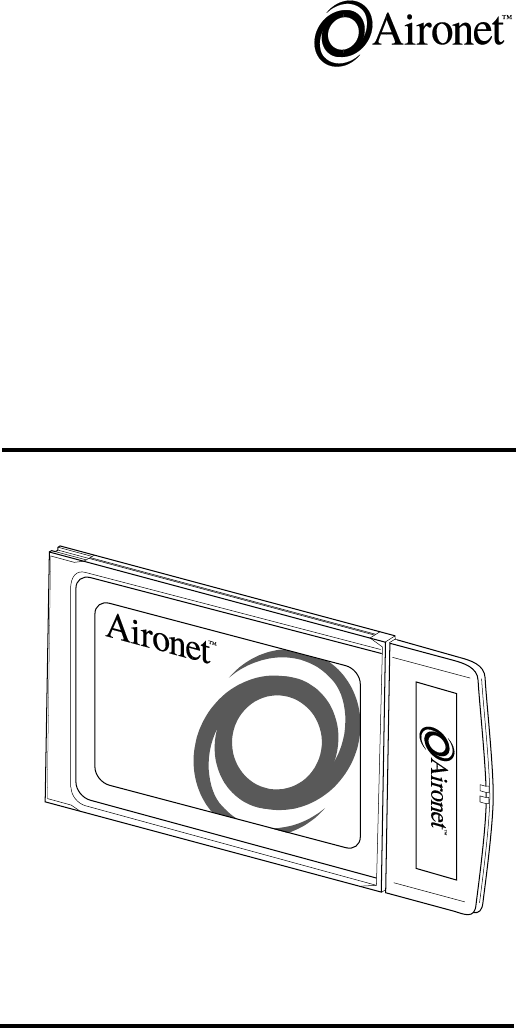
Aironet Wireless Communications, Inc. • 3875 Embassy Parkway
Akron, Ohio 44333-8357
www.aironet.com
Technical User’s Guide
4800 Series
Aironet Wireless LAN Adapter
PC4800
DOC-710-00520-A0
Aironet Wireless Communications, Inc.
No part of this document may be reproduced or transmitted in any means, elec-
tronic or mechanical, for any purpose, without the written permission of Aironet.
Information in this document is subject to change without notice. Aironet makes
no representation or warranties with respect to the contents of this manual and
specifically disclaims any express or implied warranties of merchantability or
fitness for any particular purpose.
© 1999 Aironet Wireless Communications, Inc.
All rights reserved.
LM4500TM, AP4500TM, PC4500TM, LM4800TM, AP4800TM, PC4800TM, and AironetTM
are trademarks of Aironet Wireless Communications, Inc.
Other trademarks used are properties of their respective owners.
Printed in USA
DOC-710-00520-A0

Table of Contents
i
About the Technical User’s Guide ............................... vii
Typographical Conventions ................................. viii
Section 1
Installing the Wireless LAN Adapter ..............................9
Before You Start ...................................................10
Installing the Wireless LAN Adapter .....................11
Section 2
Drivers for Special Installations ...................................25
Driver Overview ....................................................25
Windows for Workgroups NDIS2
Installation ............................................................28
DOS NDIS2 Installation ........................................29
DOS Packet Driver Installation .............................31
ODI Driver Installation ..........................................33
General Information .............................................34
Driver Keywords and Settings ..............................36
Section 3
Using the WinDGS Utilities ..........................................49
WinDGS Commands Menu .........................................49
Select Card ..........................................................49
Load New Firmware .............................................49
Edit Properties ......................................................51
Statistics ...............................................................51
Status ...................................................................51
Link Test ...............................................................52
Site Survey ...........................................................54
Radio Off/On ........................................................56
Exit .......................................................................56
Options Menu ..............................................................56
Preferences ..........................................................56
Core Dump ...........................................................57
NDIS Driver Core Dump .......................................57
Using Edit Properties ...................................................57
System Parameters ..............................................58
Network Parameters ............................................60
RF Network Parameters .......................................60
Advanced (Infrastructure) .....................................62
Advanced (Ad Hoc/IBSS) .....................................64
Using the Site Survey Active Mode Feature ................65
Destination MAC Address ....................................65
Continuous Link Test ...........................................66
Destination is Another Aironet Device ..................66
Number of Packets ...............................................66
Packet Size ..........................................................66

Table of Contents
ii
Data Retries .........................................................66
Data Rates ...........................................................66
Delay Between Packets .......................................67
Packet Tx Type ....................................................67
Packet Success Threshold ...................................67
Using the Linkscope Utility ..........................................68
Section 4
Error Messages and Troubleshooting .........................69
Indicator LEDs ......................................................69
If Your Radio Fails to Establish Contact ...............71
Appendix A
Aironet Wireless LAN Adapter Overview .....................73
Safety Information ................................................74
Radio Characteristics ...........................................76
Direct Sequence Radio Technology .....................76
Data Transparency and Protocols ........................76
Protocols Supported .............................................77
Radio Ranges ......................................................77
Radio Antenna .....................................................78
Security Features .................................................79
Terminology .........................................................79
System Configurations .........................................81
Coverage Options ................................................85
Appendix B
PC Card Specifications ...............................................89
LAN Drivers Supported ........................................89
Radio Specifications .............................................90
Power Requirements ............................................91
Physical Specifications .........................................91
Mechanical Description ........................................92
Appendix C
Channels .....................................................................93
Appendix D
Declarations of Conformity ..........................................95
Appendix E
Technical Support .....................................................101

About the Technical User’s Guide
iii
About the Technical User’s
Guide
This guide covers the installation, configuration, control,
and maintenance of your Aironet 4800 Series PC Card
Wireless LAN Adapter. The Guide is arranged as follows:
Section 1 – Installation – describes installation of the PC
Card.
Section 2 – Drivers for Special Installations – describes
installation and configuration of the various network drivers.
Section 3 – Utilities – provides detailed procedures for
using the utilities to load new firmware versions, as well as
how to perform link tests and site surveys.
Section 4 – Error Messages and Troubleshooting –
provides detailed descriptions of the LED messages and
error codes, as well as general procedures for correcting
common problems.
Appendix A – Aironet Wireless LAN Adapter Overview –
provides a general introduction to the 4800 Series PC Card,
direct sequence radio technology, and the various configu-
rations you can use when operating the 4800 Series PC
Card in your infrastructure.
Appendix B – Specifications – provides radio and physical
specifications.
Appendix C – Channels – provides channel identifiers and
channel center frequencies for various area regulatory
agencies.
Appendix D – Declarations of Conformity – provides
conformity information about the 4800 Series Wireless LAN
Adapter.
Appendix E – Technical Support – provides contact
information for Aironet.

About the Technical User’s Guide
iv
Typographical Conventions
When reading the User’s Guide and Technical Reference
Manual, it is important to understand the symbol and
formatting conventions used in the documentation. The
following symbols are used in the guide.
Convention Type of Information
Indicates a note which contains important
information.
Indicates procedures which, if not observed,
could result in loss of data or damage to the
equipment.
Bold type An action you must perform, such as typing a
character or making a selection with your
mouse.

Section 1: Installing the Wireless LAN Adapter
1
Section 1
Installing the Wireless LAN
Adapter
This section describes the procedures for installing the
Wireless LAN Adapter.
Here’s what you’ll find in this section:
• Before You Start
• Installing the Wireless LAN Adapter

Section 1: Installing the Wireless LAN Adapter
2
Before You Start
For the PC Card to be used with a computing device (desk-
top personal computer, notebook, laptop computer, portable
or hand-held device), the device must be equipped with an
internal or external PC Card Type II or Type III slot. All driv-
ers and supporting software (card and socket services) for
the PC Card slot must be loaded and configured.
After unpacking the PC Card, make sure the following items
are present and in good condition:
•PC4800 Wireless LAN Adapter
•Software Driver Diskette
•Utilities Diskette
If any item is damaged or missing, contact your Aironet sup-
plier. Save all shipping and packing material to repack the
unit should service be required.
NOTE: Any remote antenna and its associated wiring are
ordered and packed separately.

Section 1: Installing the Wireless LAN Adapter
3
Installing the Wireless LAN Adapter
This section provides instructions for installing an Aironet
client card on a computer using Windows 95 or 98, and on a
computer using Windows NT. The instructions for Windows
95 and 98 show screens typical in Windows 98, and the
instructions for Windows NT show screens typical in NT
4.0. If your computer uses Windows 95 or Windows NT
3.51, your screens will differ slightly.
If you are installing your client card on a computer using
Windows for Workgroups, DOS, Novell Netware, or any
other ODI-compliant DOS environment, see Section 2 —
Drivers for Special Installations.
Before you begin, examine the PC Card. One end is a dual-
row, 68-pin PC Card connector. This side will be inserted
into the PC Card slot with the Aironet logo on the PC Card
facing up. The card is keyed so it can be inserted only one
way into the PC Card slot.
CAUTION: The following procedures and physical
connections apply generally to normal and conventional
PC Card slots. In the cases of custom or non-
conventional equipment, be alert to possible differences
in PC Card slot configurations.
The PC Card can be connected to a PC Card Type II slot.
This includes slots that support both Type II and Type III
cards.
CAUTION: Do not force the PC Card into the PC Card
slot. Forcing it will damage both the PC Card and the slot.
If the PC Card does not go in easily, remove the card and
re-insert it.
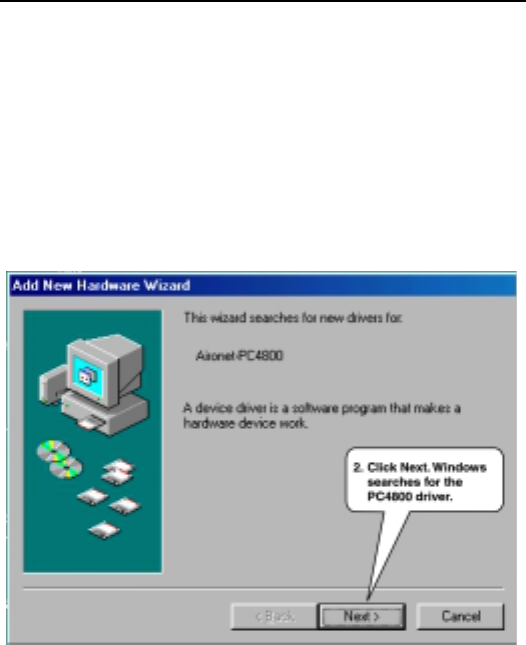
Section 1: Installing the Wireless LAN Adapter
4
If the operating system on your computer is Windows
95 or 98, follow these steps:
1. While your computer is up and running, hold the PC
Card so the Aironet logo is facing up, and slide the
PC Card into the slot until its connector is firmly
seated and the slot’s eject button pops out. The
New Hardware Found window appears briefly, fol-
lowed by the Add New Hardware window:
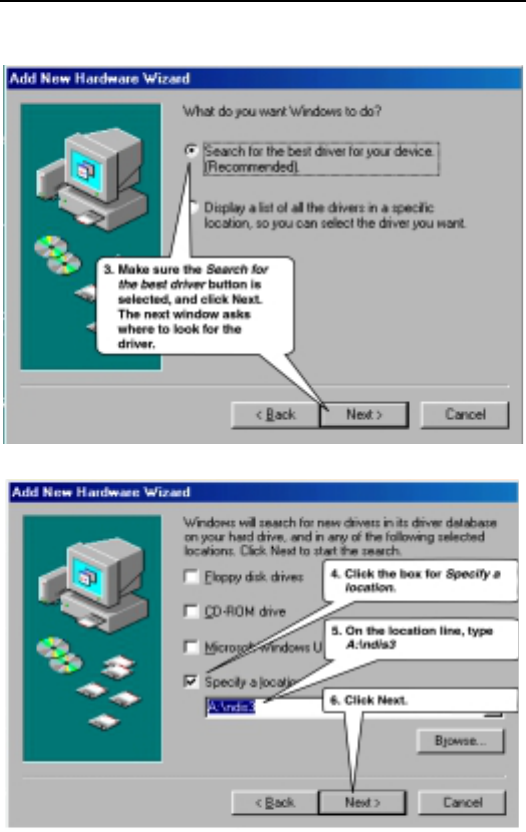
Section 1: Installing the Wireless LAN Adapter
5
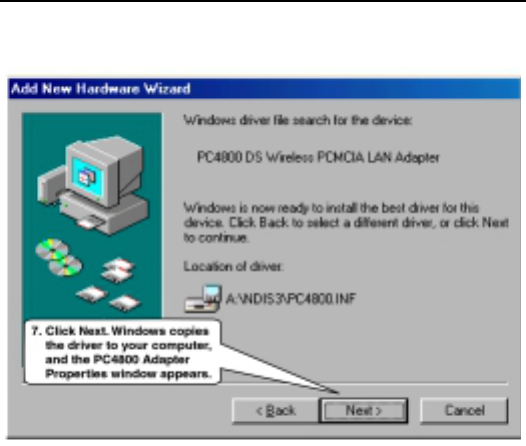
Section 1: Installing the Wireless LAN Adapter
6
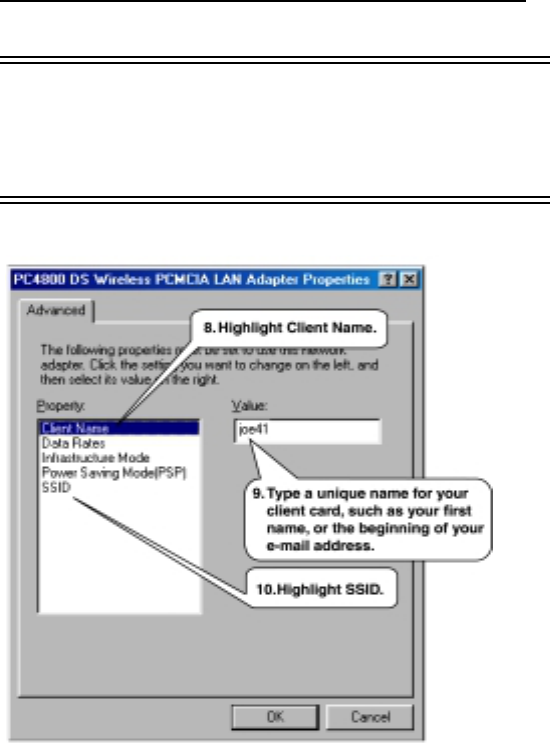
Section 1: Installing the Wireless LAN Adapter
7
Note: Steps 8, 9, 10, and 11 allow you to name your client
card and specify the name of the access point your card will
“talk to.” Your client card will work fine if you skip these steps,
however. For the simplest setup of your client card, click OK
and skip to step 13 of these instructions.
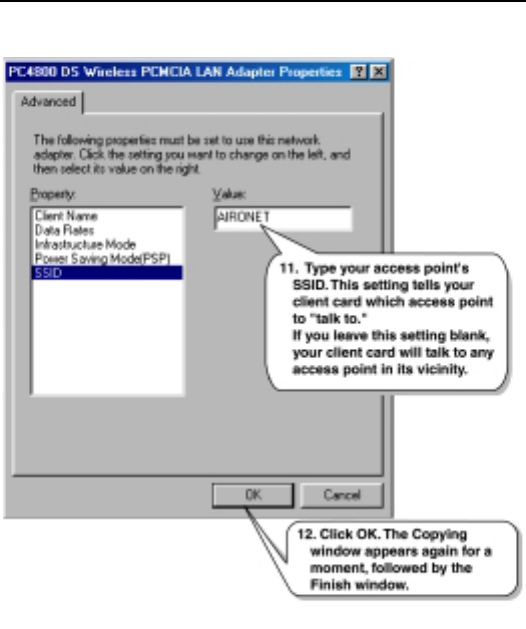
Section 1: Installing the Wireless LAN Adapter
8
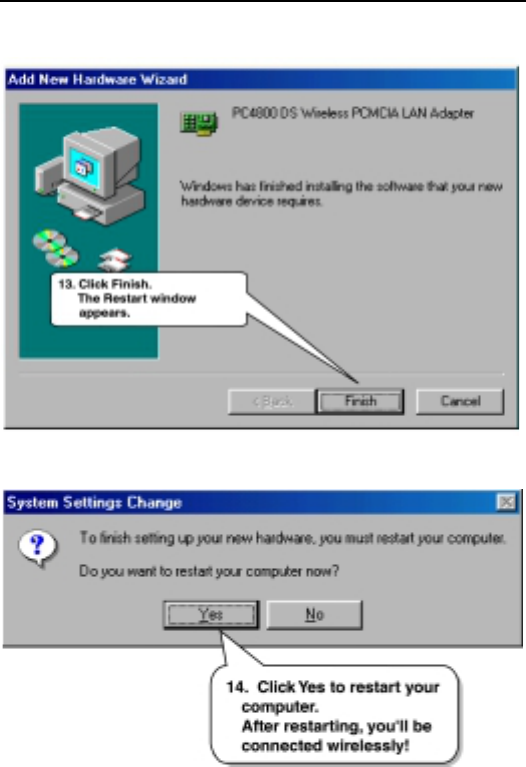
Section 1: Installing the Wireless LAN Adapter
9
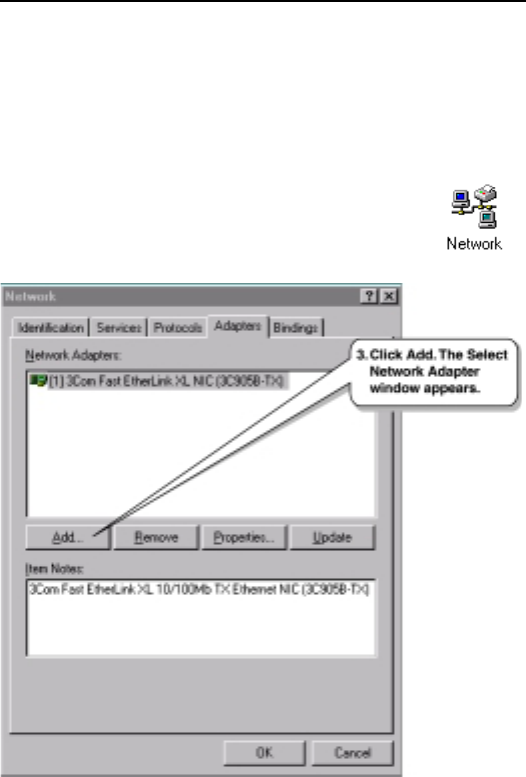
Section 1: Installing the Wireless LAN Adapter
10
If the operating system on your computer is Windows
NT, follow these steps:
1. Turn your computer off, plug the card into the PCM-
CIA slot, and turn the computer back on.
2. On your Windows Control Panel (click
the Start button, then select Settings,
then Control Panel), select the Network
icon. The Network window appears.
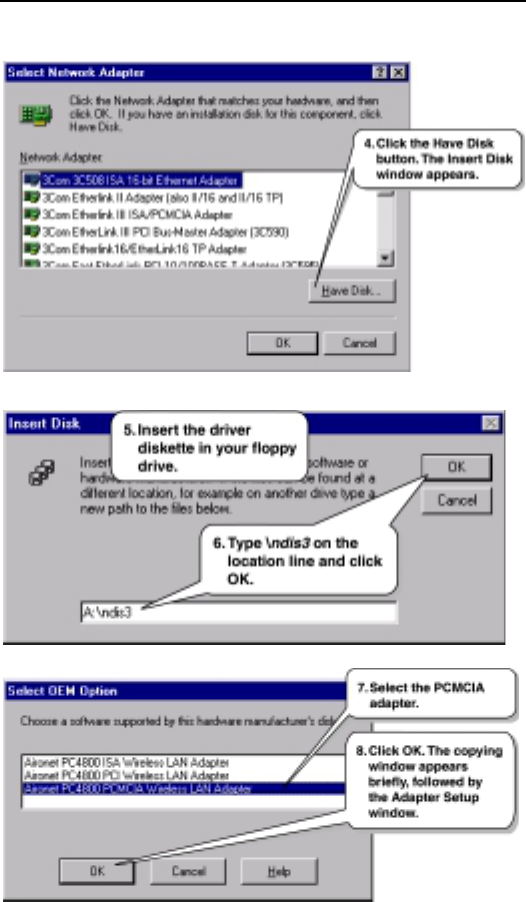
Section 1: Installing the Wireless LAN Adapter
11
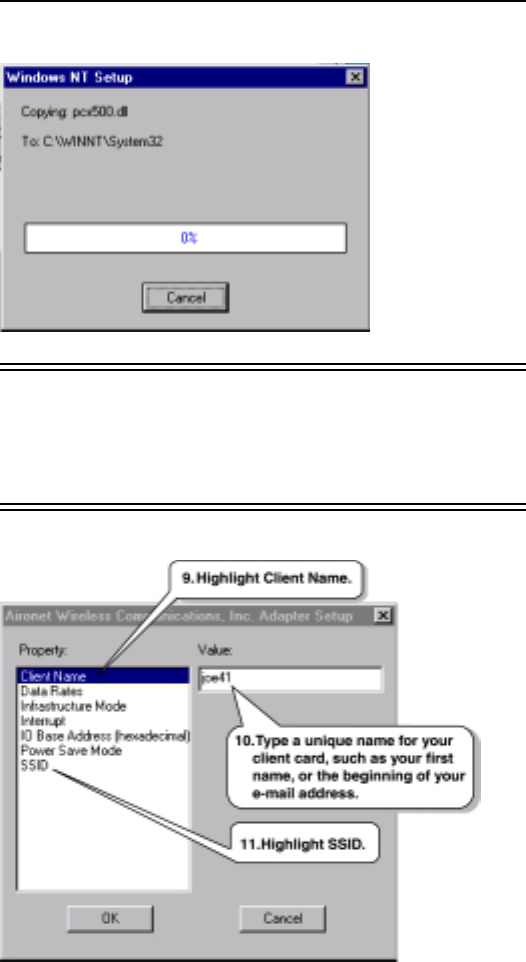
Section 1: Installing the Wireless LAN Adapter
12
Note: Steps 9, 10, 11, and 12 allow you to name your client
card and specify the name of the access point your card will
“talk to.” Your client card will work fine if you skip these
steps, however. For the simplest setup of your client card,
click OK and skip to step 14 of these instructions.
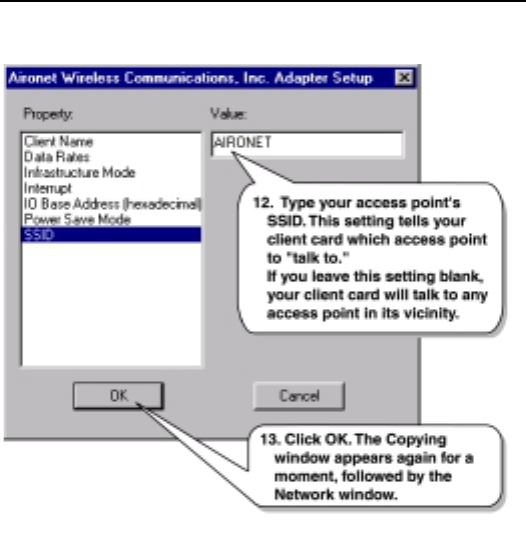
Section 1: Installing the Wireless LAN Adapter
13
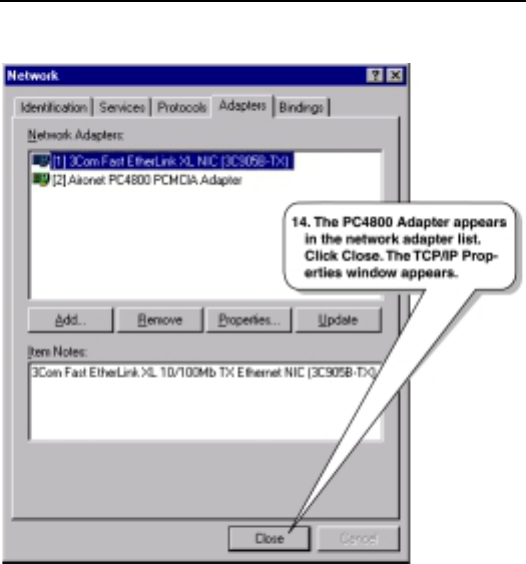
Section 1: Installing the Wireless LAN Adapter
14
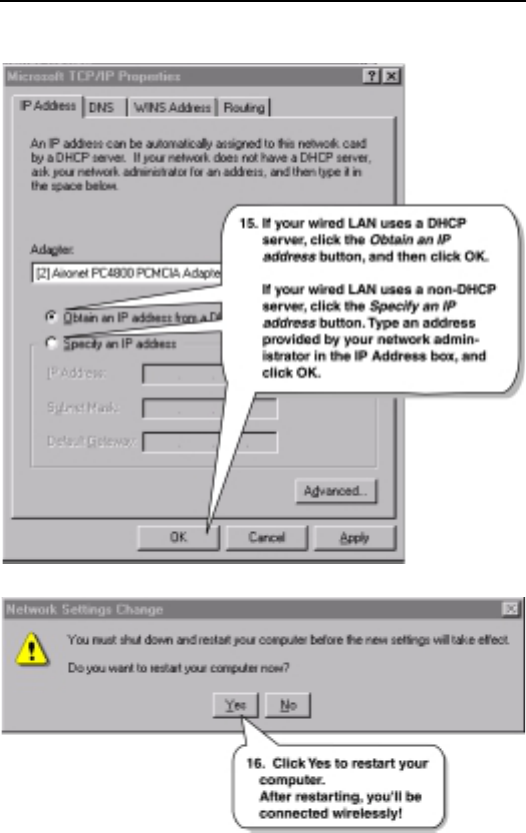
Section 1: Installing the Wireless LAN Adapter
15

Section 1: Installing the Wireless LAN Adapter
16

Drivers for Special Installations
17
Section 2
Drivers for Special Installa-
tions
The PC Card is supplied with PACKET, NDIS2, NDIS3 and
ODI drivers allowing operation under DOS, Windows 3.x,
Windows for Workgroups, Windows 95, Windows 98, Win-
dows NT, and Novell Netware. The PC Card is fully IEEE
802.11 compliant.
Driver Overview
The PC Card is shipped with two diskettes:
• WinDGS diagnostics diskette
• Aironet driver diskette
This section covers the drivers. The utilities are discussed
in Section 3 – Utilities.
To use the DOS, Windows 3.x and Windows for Work-
groups based drivers, you must create or edit a configura-
tion file created with an ASCII text editor. Installation of
each driver is discussed in the following tables.

Drivers for Special Installations
18
The driver disk shipped with the Wireless LAN Adapter is
organized as follows:
Table 2.1 - Driver Disk Structure
README.TXT Contains latest information about the disk
contents
DIAG Directory containing utilities
FLSH3545.COM PC card flash firmware
45C???.BIN Latest firmware release
NDIS2 Directory containing NDIS2 driver files
AWC2N45C.DOS NDIS2 driver
OEMSETUP.INF NDIS2 compatible install file for MicroSoft
Windows for Workgroups
PROTOCOL.INI The required configuration file for the NDIS2
driver. The PROTOCOL.INI file on the diskette
provides sample entries for operation in
Infrastructure Mode.
PROTOCOL.AHC Sample PROTOCOL.INI file with entries for
Ad Hoc Mode
PKT Directory containing DOS packet driver files
AWCP45C.COM DOS based packet driver
AWCPKT.INI The required configuration file for the Packet
driver. The AWCPKT.INI file on the diskette
has sample entries for operation in
Infrastructure Mode.
AWCPKT.AHC Sample AWCPKT.INI file with entries for
Ad Hoc Mode.

Drivers for Special Installations
19
NDIS3 (PC4500) Directory containing NDIS3 driver files
PC4500.INF WIN95/98 install file
PC4500.SYS NDIS3 driver
PC4500.DLL NDIS3 library
VXD4500.VXD Virtual device driver for Aironet WinDGS utility
OEMSETUP.INF WIN NT install file
ODI Directory containing ODI driver files
AWCO45C.COM PC4500 DOS based ODI driver
NET.CFG The required configuration file for ODI. The
NET.CFG file on the drive diskette contains
sample entries for operation in Infrastructure
Mode.
NDIS3 (PC4800) Directory containing NDIS3 driver files
PC4800.INF WIN95 install file
PC4800.SYS NDIS3 driver
PC4800.DLL NDIS3 library
VXD4800.VXD Virtual device driver for Aironet WinDGS utility
OEMSETUP.INF WIN NT install file
ODI Directory containing ODI driver files
AWCO45C.COM PC4800 DOS based ODI driver
NET.CFG The required configuration file for ODI. The
NET.CFG file on the drive diskette contains
sample entries for operation in Infrastructure
Mode.

Drivers for Special Installations
20
Windows for Workgroups NDIS2
Installation
1. Turn on your computer and start Windows for Work-
groups.
2. Go to the Network program group and click on Network
Set-Up.
3. Under Network Setup, choose Networks.....
4. Under Networks, choose Install Microsoft Windows
Network. Select OK.
5. Under Network Setup, choose Drivers....
6. Under Network Drivers, choose Add Adapters.
7. If the drivers were already copied to the hard disk, they
will be displayed in the list.
8. Under Add Adapter, choose the appropriate Aironet
Adapter. If it is not on the menu list, choose Unlisted or
Updated Network Driver. The Install Driver pop up
window will ask you for the Aironet driver disk.
9. Place the driver disk in drive A.
10. Type A:\NDIS2\ at the prompt and press Enter.
11. Choose the correct Aironet Adapter and click OK.
12. If the chosen adapter is displayed in the Network
Drivers, click on Setup.
13. Select the appropriate parameters, such as Infrastruc-
ture Mode, SSID, Channel, and Bitrate.
14. Exit Windows for Workgroups.
15. To modify the PC Card system parameters, edit the
PROTOCOL.INI file in the Windows directory.
16. Reboot your computer.

Drivers for Special Installations
21
DOS NDIS2 Installation
The Aironet Wireless LAN Adapter can be installed in a
NetBIOS compliant DOS environment such as MicroSoft
LAN Manager or PC LAN.
The installation of this driver includes creating or editing a
configuration file (PROTOCOL.INI).
PROTOCOL.INI must contain the following lines:
Table 2.2 - Minimum PROTOCOL.INI Driver Settings
Additional variables defined in the following section may
also be used.
1. Power on your computer.
2. Copy the \NDIS2\AWC2N45C.DOS from the Aironet
Device Driver diskette to the directory containing the
network files.
3. Copy the PROTOCOL.INI file to the network directory
or merge statements from the Aironet supplied file into
your existing PROTOCOL.INI file.
4. Modify the CONFIG.SYS file. After the line containing:
Device=PROTMAN.DOS, add Device=[drive:] [path]
AWC2N45C.DOS.
Infrastructure Mode Ad Hoc Mode
[AW2N45C] [AW2N45C]
DRIVERNAME=AWC2N45C$ DRIVERNAME=AWC2N45C$
If INFRASTRUCTURE is omitted
the default will be “ON”INFRASTRUCTURE = “NO”
SSID = “your_SSID_here”SSID = “your_SSID_here”
CHANNEL = <channel>

Drivers for Special Installations
22
5. To modify the PC Card system parameters, edit the
PROTOCOL.INI file in the network directory. For a list
of parameters which can be modified, see Table 2.2.
6. Reboot your computer.

Drivers for Special Installations
23
DOS Packet Driver Installation
The installation of this driver includes creating or editing a
configuration file (AWCPKT.INI). This file must contain the
following lines:
Table 2.3 - Minimum AWCPKT.INI Driver Settings
Additional variables defined in the following section may
also be used.
The Wireless LAN Adapter can be installed in a DOS
environment using DOS IP stack products such as FTP
software.
1. Power on your computer.
2. Copy the \PKT\AWCP45C.COM file from the Aironet
Device Driver diskette to the directory containing the
network files.
3. Copy the AWCPKT.INI file from the Aironet Device
Driver diskette to the directory containing the Packet
driver.
4. If you would like to modify the PC Card system parame-
ters, edit the AWCPKT.INI file. For a list of parameters
which can be modified, see Table 3.3.
Infrastructure Mode Ad Hoc Mode
[AWCPKT] [AWCPKT]
If INFRASTRUCTURE is omit-
ted the default will be “ON”INFRASTRUCTURE = “NO”
SSID = “your_SSID_here”SSID = “your_SSID_here”
CHANNEL = <channel>

Drivers for Special Installations
24
5. Load the driver by typing AWCP45C [-cinuw]
<int_number> at the DOS prompt (i.e. AWCP45C
0x65) and press Enter.
NOTE: To unload the driver, type AWCP45C
–u <int_number> (i.e. AWCP45C –u 0x65).
6. Load the DOS IP stack.
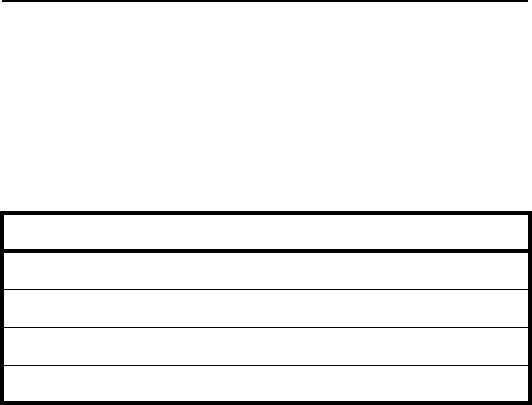
Drivers for Special Installations
25
ODI Driver Installation
The PC Card can be installed in an ODI compliant DOS
environment such as Novell NetWare.
Table 2.4 - Minimum NET.CFG Driver Settings
1. Power on your computer.
2. Copy the \ODI\AWCO45C.COM driver from the Aironet
Driver diskette to the directory containing the network
files.
3. Copy the \ODI\NET.CFG file from the Aironet Driver dis-
kette or merge the Aironet supplied NET.CFG file into
your existing NET.CFG file in the network directory.
4. Modify the PC Card system parameters by editing the
NET.CFG file. For a list of parameters which can be
modified, see Table 3.4.
5. Run the batch files created by the NetWare installation
disks or manually load the driver from AUTOEXEC.BAT
or the command line. This can be done by running LSL,
followed by AWCO45C, IPXODI, and NETX or VLM.
Infrastructure Mode
Link Driver AWCO45C
If INFRASTRUCTURE is omitted the default will be “ON”
SSID = “your_SSID_here”
CHANNEL = <channel> (only required in ad hoc mode)

Drivers for Special Installations
26
General Information
•AWCPKT.INI file must have a section header of
[AWCPKT].
•PROTOCOL.INI file can have any section header, but
the section must contain the keyword and parameter
DRIVERNAME=ìAWC2N45C$î.
•NET.CFG file must have a section header of
[Link Driver AWCO45C].
NOTE: These lines may appear anywhere within a
section. Only the sections that contain these lines will be
parsed.
•Multiple sections are supported.
•Blank lines are supported.
•Comments begin with semi-colon and may appear any-
where on a line.
•Keywords can be upper or lower case and may be sur-
rounded by white space if desired.
•Any parameter that begins with “0x” will be assumed to
be hexadecimal. Any parameter that begins with a digit
(excluding the “0x” case) will be assumed to be deci-
mal. Any parameter that begins with quotes will be
assumed to be a quoted string parameter. Any other
parameter will be assumed to be an unquoted string
parameter.
•For PROTOCOL.INI string parameters, double quotes
are required around the string if the string contains any
special characters.
NOTE: PROTOCOL.INI does not support some of the
white space characters in a quoted string. If a string
begins with an alphabetic character and contains no
special characters, the quotes may be omitted.

Drivers for Special Installations
27
•For Packet string parameters, the string can be
enclosed with double quotes or single quotes. If a string
is quoted, any character except a “null” and the quote
delimiter itself can occur between the quotes.
NOTE: If double quotes are used for a delimiter, a single
quote may appear in the string, and vise versa. If the
string begins with an alphabetic character and contains
no special characters, the quotes may be omitted.
•For numeric parameters, the value can be hexadecimal
or decimal. Hexadecimal numbers must be preceded
with the characters “0x” but all characters can be upper
or lower case.
•Mac address parameters are parsed as string parame-
ters, therefore, the addresses must be enclosed in sin-
gle or double quotes.
NOTE: The MAC address cannot be a multicast address.

Drivers for Special Installations
28
Driver Keywords and Settings
The default PC Card configuration is set to:
•Constant Awake Mode
•Infrastructure Mode – This allows association with any
Aironet Access Point matching the SSID supplied by
the user
•The factory supplied network address
•Receive directed packets to this address as well as
multicasts and broadcasts
•Retry data packets up to 16 times before discarding the
frame
•Retry RTS sequence up to 16 times before discarding
the frame
•RTS exchange on all frames greater than 300 bytes
•Fragment frames longer than 700 bytes
•Kill fragmented transmit packets if not delivered in
5 seconds
•Kill fragmented receive frames if not complete after
10 seconds
•Active scanning with 3 Kµsec energy detect time and
20 Kµsec probe response wait timeout
•Re-scan if eight beacons are consecutively missed
•Send an Access Point keep-alive message every
10 seconds

Drivers for Special Installations
29
The following tables contain keywords and parameter set-
tings common to both the NDIS2 PROTOCOL.INI, ODI
NET.CFG, and the PKT AWCPKT.INI configuration files.
Basic system operation can be adjusted with the following
parameters.
Table 2.5 - General Network Keywords
Keywords Value Description
INFRASTRUCTURE ON, YES
OFF, NO Optional – specifies whether system
operation uses an infrastructure or
peer-to-peer/ad hoc network
(default is ON, YES).
SSID 1 to 32 character
string This parameter must match the
SSID of the system for proper
operation.
NODENAME 1 to 16 character
string Optional – specifies a readable
name for the station.
NETADDRESS Any IEEE MAC
address except
broadcast and
multicast
Optional – this setting allows for
locally administered MAC
addresses by overriding the unique
MAC ID on the PC Card.
NODE ADDRESS Same as NETADDRESS (keyword
only valid in NET.CFG file).
RXMODE NORMAL,
UNICAST,
NOMULTICAST
Optional – this setting determines
what frames are delivered to the
driver from the PC Card (default is
NORMAL). NORMAL indicates
unicast, multicast and broadcast
frames are received.
DATARATE1 0-255 Optional – specified in increasing
speed to identify the network
configuration to associate to
(default is 1_2 [4500] or
1_11 [4800]).
DATARATE2 0-255 Optional – specified in increasing
speed to identify the network
configuration to associate to.

Drivers for Special Installations
30
Network performance can be optimized with the following
variables.
Table 2.6 - Advanced Network Keywords
Keywords Value Description
LONGRETRYLIMIT 0 – 255 Optional – specifies the number of
times an unfragmented packet will
be retried before the packet is
dropped and a transmit error is
reported to driver (default is 16).
SHORTRETRYLIMIT 0 – 255 Optional – specifies the number of
times that a fragmented packet will
be retried to gain access before a
packet is dropped and a transmit
error is reported to the driver
(default is 16).
RTSTHRESHOLD 0 – 2312 Optional – specifies the minimum
frame size, in bytes, for which RTS/
CTS delivery will be used. Packets
longer than this value will be deliv-
ered using RTS/CTS handshaking
(default is 300).
TXMSDULIFETIME 0 – 0xFFFF Optional – specifies the maximum
time to attempt packet delivery
(default is 5,000 Kµsec
[5 seconds]).
RXMSDULIFETIME 0 – 0xFFFF Optional – specifies the maximum
time for receiving a fragmented
packet (default is 10,000 Kµsec
[10 seconds]).
TXPOWERLEVEL 0 – 100 Optional – selects the next highest
programmed power level for trans-
mit in mW.
RXDIVERSITY DEFAULT, ON,
RIGHT, LEFT Optional – specifies the receive
diversity method to be used by the
PC Card (default is on).
TXDIVERSITY DEFAULT, ON,
RIGHT, LEFT Optional – specifies the transmit
diversity method to be used by the
PC Card (default is on).

Drivers for Special Installations
31
Additional system performance adjustments can be made
with the following group of variables.
Table 2.7 - Fragmentation Keywords
Keywords Value Description
FRAGTHRESHOLD 256 – 2312 (must
be even) Optional – specifies the fragmenta-
tion size in bytes. Frames longer
than this value will be transmitted
using multiple packets (default is
700).

Drivers for Special Installations
32
The Wireless LAN Adapter power management can be
adjusted with the following group of variables.
Table 2.8 - Power Management Keywords
Keywords Value Description
POWERSAVEMODE CAM, PSP,
FASTPSP Optional – specifies a particular
operational mode (default is CAM).
CAM = Constant Awake Mode
PSP = Power Save Mode
FASTPSP = Fast Power Save Mode
Note: In Ad Hoc Mode, ATIMDU-
RATION must also be set.
ATIMDURATION Between 0 and
less than the
beacon interval.
Optional – ad hoc/IBSS only – spec-
ifies the length of time in Kµsec for
ATIMs following a beacon (this
value must be non-zero for PSP ad
hoc operation. 0 is Constant Awake
Mode (default is 5).
This value is only used when start-
ing a new network. When joining a
network, the value currently in use
will be adopted.
SLEEPFORDTIM ON, OFF Optional – infrastructure with PSP
or Fast PSP Modes only – if ON, the
node is allowed to sleep through
DTIMs for extra power saving.
Broadcast and multicast traffic may
be missed (default is OFF).
LISTENTIME 0 – 0xFFFF Optional – infrastructure with PSP
or Fast PSP Modes only – deter-
mines how often to awaken for bea-
cons. Note that the PC Card will
always awaken to receive DTIMs
when in PSP Mode, unless sleep for
DTIMs is set (default is 200 Kµsec
[200 ms]).

Drivers for Special Installations
33
Table 2.8 - Power Management Keywords (Continued)
Keywords Value Description
FASTLISTENTIME 0 – 0xFFFF Determines how often to awaken for
beacons. Note that the PC Card will
always awaken to receive DTIMs
when in Fastpsp Mode (default is
100 Kµsec).
LISTENDECAY 0 – 0xFFFF Optional – infrastructure with PSP
or Fast PSP Modes only – rate at
which the listen interval grows. The
number of times to use the current
listen interval before doubling it.
Listen interval will begin at
FASTLINSTENTIME and eventu-
ally decay to LISTENTIME (default
is 2).
FASTLISTENDELAY 0 – 0xFFFF Optional – infrastructure with PSP
or Fast PSP Modes only – time to
delay immediately after a transmis-
sion before beginning at
FASTLISTENTIME (default is 200
Kµsec).

Drivers for Special Installations
34
Additional system performance adjustments can be made
with the following group of variables.
Table 2.9 - Scanning Keywords
Keywords Value Description
SCANMODE ACTIVE,
PASSIVE,
ADVANCED
Optional – parameter to determine
the current scanning mode to be
used by the PC Card (default is
ACTIVE).
BEACONLISTENTO 0 – 0xFFFF Optional – for passive scanning
mode, determines the amount of
time (Kµsec) to listen for a beacon
on each channel (default is 40
Kµsec).
PROBEENERGYTO 0 – 0xFFFF Optional – for active scanning mode,
determines the amount of time to lis-
ten for RF energy following a probe
(default is 3 Kµsec).
PROBERESPON-
SETO 0 – 0xFFFF Optional – for active scanning mode,
determines the amount of time to
wait for a probe response after
energy is detected on a channel
(default is 20 Kµsec).
STATIONARY ON, OFF,
YES, NO Optional – indicates whether or not
the station is mobile (default is
OFF).
PROBEDELAY 0 – 0xFFFF Optional – indicates how long to wait
on a frequency before sending a
probe request (default is 3 Kµsec).
OFFSCANINTERVAL 0 – 0xFFFF Optional – how often to attempt to
use the “off line” scanning method to
search for new Access Points
(default is 0 which disables off line
scanning).
OFFSCANDURATION 0 – 0xFFFF Optional – how long to use the “off
line” scanning method during each
attempt (default is 0 which disables
off line scanning).

Drivers for Special Installations
35
Additional system performance adjustments can be made
with the following parameters.
Table 2.10 - Infrastructure Keywords
Keywords Value Description
SSID 1 to 32 charac-
ter string This parameter must match the
SSID of the system for proper infra-
structure operation.
BEACONLOSTTIME 0 – 0xFFFF Optional – determines the interval of
consecutively missed beacons
which will cause a re-scan (default is
500 Kµsec).
REFRESHINTERVAL 0 – 0xFFFF Optional – determines the amount of
time in seconds between refresh
packets to the Access Point. Use
0xFFFF to disable (default is 10,000
Kµsec [10 sec]).
SPECIFIEDAP Any IEEE MAC
address except
broadcast and
multicast
Optional – forces association to the
specified Access Point.
SPECIFIEDAP2 Any IEEE MAC
address except
broadcast and
multicast
Optional – forces association to one
of the specified Access Points.
SPECIFIEDAP3 Any IEEE MAC
address except
broadcast and
multicast
Optional – forces association to one
of the specified Access Points.
SPECIFIEDAP4 Any IEEE MAC
address except
broadcast and
multicast
Optional – forces association to one
of the specified Access Points.

Drivers for Special Installations
36
Table 2.10 - Infrastructure Keywords (Continued)
Keywords Value Description
SPECIFIEDAPTO 0 – 0xFFFF Optional – time in Kµsec to attempt
to associate to a specified Access
Point before searching for any avail-
able Access Points (with matching
SSID) (default is 10,000 Kµsec [10
sec]).
AUTHTIMEOUT 0 – 0xFFFF Optional – time to attempt to authen-
ticate to an Access Point (default is
2,000 Kµsec [2 sec]).
AUTHTYPE OFF, OPEN,
HAREDKEY,
ENCRYPTONLY
Optional – determines the level of
security of the wireless network
(default is OPEN).
ASSOCIATIONTO 0 – 0xFFFF Optional – indicates the maximum
amount of time the client will wait for
a response to an association
request from the Access Point
(default is 2,000 Kµsec [2 sec]).

Drivers for Special Installations
37
Ad hoc system operation is accomplished with the following
group of variables.
Table 2.11 - Ad Hoc Keywords
Keywords Value Description
JOINNETTO 0 – 0xFFFF Optional – determines the amount of
time that an ad hoc station will scan
before starting its own network
(default is 10,000 Kµsec [10 sec]).
BEACONPERIOD 0 – 0xFFFF Optional – specifies the beaconing
interval in Kµsec. (default is 100
Kµsec).
DSCHANNEL 0-14 Optional – this parameter is valid
only for a node that starts a network.
This is the channel identifier specify-
ing the frequency to communicate
on. For all other nodes, the radio will
scan for the proper frequency.
Default is 0, which will cause the
radio to pick a default channel
appropriate for its programmed
carrier set. Any other value (1-14)
will be validated against the
programmed carrier set and rejected
if invalid.
ATIMDURATION Between 0 and
less than the
beacon interval
Ad hoc only – specifies the length of
time for ATIMs following a beacon
(this value must be non-zero for
PSP ad hoc operation) (default is 5).
This value is only used when start-
ing a new network. When joining a
network, the value currently in use
will be adopted.

Drivers for Special Installations
38
The following is a list of keywords that will control the host
system hardware resources the Aironet 4000 Series Wire-
less LAN Adapter requires.
NOTE: At a minimum, the PC Card requires 64
consecutive 16-bit I/O ports, one non-sharable Interrupt
and one PC Card type II slot.
If you are using card services, these resources will be
assigned for you. However, you may override the card ser-
vices resource assignments by including the PortBase and/
or INT/IRQ keywords in the appropriate configuration file.
If you are not using card services, your host system must
have an Intel 82365 or compatible PC Card controller chip.
The 4000 Series driver will then configure the PC Card
controller chip directly and each of the following parameters
should be specified in your configuration file.

Drivers for Special Installations
39
Table 2.12 - PC Card Keywords
Keywords Value Description
PORTBASE 0 – 0xFFFF Optional – specifies the starting
address for a block of 64 consecu-
tive 16-bit I/O ports. Make sure the
block of I/O addresses does not
overlap the address of another
device in the machine. This can be
used to override a card service
assignment. If card services are not
used, this will default to 0x140.
PORT Only valid in NET.CFG file (same as
PORTBASE).
INT 2-15 Optional – specifies the hardware
interrupt the PC Card will use. The
Interrupt must be unique (i.e. not
used by another device in the
machine). This can be used to over-
ride a card service assignment. If
card services are not used, this will
default to 11.
IRQ Same as INT.
SOCKET 0-7 Optional – If card services are used,
this keyword is ignored. If card ser-
vices are not used, this is the PC
Card socket the PC Card is inserted
into (default is 0).
MEMORY 0xC000 –
0xDF00 Optional – If card services are used,
this keyword is ignored. If card ser-
vices are not used, this is a block of
memory the driver will use to view
the PC Card CIS (default is
0xD000). In the NET.CFG file the
parameter is D0000, not 0xD000.
MEM Same as MEMORY.

Drivers for Special Installations
40
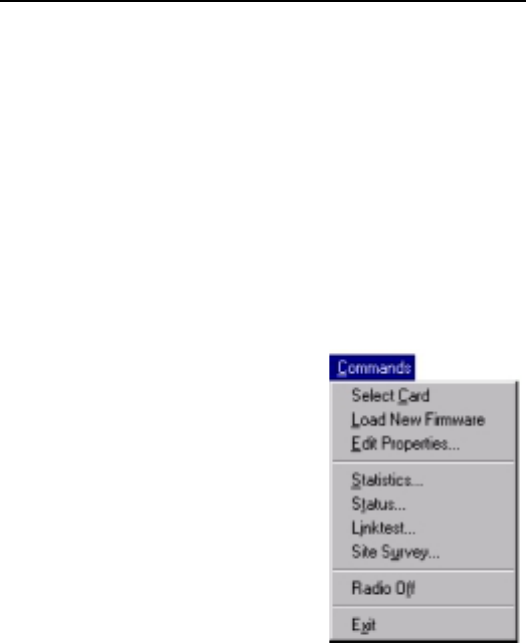
Section 3: Using the WinDGS Utilities
41
Section 3
Using the WinDGS Utilities
WinDGS is used to perform user level diagnostics on your
Aironet Wireless LAN Adapter Card in the Windows 95, 98,
or Windows NT operating system environment.
WinDGS Commands Menu
The Commands Menu includes:
•Select Card
• Load New Firmware
• Edit Properties
•Statistics
•Status
•Link Test
• Site Survey
• Radio Off/On
•Exit
Select Card
This allows another installed Aironet Wireless LAN Adapter
Card to be chosen. The property screens will change to
reflect the parameters specific to each card type.
Load New Firmware
The firmware is contained in the card’s flash memory. Flash
memory allows for easy updating of the firmware as neces-
sary.

Section 3: Using the WinDGS Utilities
42
Upgrading Firmware for Windows 95
or Windows 98
The WinDGS program is used to load new firmware.
To load new firmware:
1. Make sure the PC Card is up and running.
2. Select Commands.
3. Select Load New Firmware.
4. Select Look In....Use the drop down button to select
the appropriate path and image file.
5. Select Open. This will flash the card with the selected
image.
Upgrading Firmware for Windows 3.11 and DOS
The FLSH3545.COM program is used to load new firmware
to systems operating under DOS and Windows 3.11.
To load new firmware:
1. Before upgrading the firmware, uninstall the driver or
reboot the computer and do not load the driver during
the boot process.
2. Type FLSH3545 at the DOS prompt.
3. Enter the option (see Table below).
NOTE: If using card and socket services, no options
should be required.

Section 3: Using the WinDGS Utilities
43
4. Type the filename of the new firmware.
5. Press Enter.
Edit Properties
WinDGS allows you to change the configuration parame-
ters of your currently installed Aironet 4000 Series Wireless
LAN Adapter. See “Using Edit Properties” on page 3-49 for
details on this command.
Statistics
The Statistics screen shows the current statistics from the
PC Card. Statistics are updated at the rate specified by the
Screen Update Timer. Clear the current statistics by clicking
on Reset. Exit the Statistics screen by clicking on OK, or by
clicking on the X in the upper right hand corner of the dialog
box.
Status
The Status screen shows the current status from the PC
Card. Status is updated at the rate specified by the Screen
Update Timer. Exit the Status screen by clicking on OK, or
Utility Description
-p Specifies the starting address for a block of 64 consecutive
16-bit I/O ports. Make sure the block of I/O addresses does
not overlap the address of another device in the machine.
This can be used to override a card service assignment. If
card services are not used, this will default to 0x140.
-s Optional – If card services are used, this parameter is
ignored. If card services are not used, this is the PC Card
socket the PC Card is inserted into (default is 0).
-m If card services are used, this parameter is ignored. If card
services are not used, this is a block of memory the driver will
use to view the PC Card CIS (default is 0xD000).
-q Quiet Mode, no messages will appear while flash upgrade is
in progress.

Section 3: Using the WinDGS Utilities
44
by clicking on the X in the upper right hand corner of the
dialog box.
Link Test
You can use WinDGS to assess the performance of RF
links. TCP/IP protocol must be installed on your system to
run this link test. See the Windows 95/98/NT Help section
for more information on installing and setting up TCP/IP. An
IP address must also be configured for the Access Point.
1. From the link test command menu, enter the following
parameters:
• IP address of Aironet Access Point:
This parameter specifies the IP address of the
Access Point with which you want to test the RF link.
Set this value before running the link test.
•Number of Packets:
This parameter specifies the number of packets the
link test will attempt to send. The display will show
the number of packets of the specified size that are
successfully transmitted and received. This parame-
ter is ignored if Continuous Link Test is selected.
•Packet Size:
This parameter specifies the size of the data packet
to be sent to the Aironet Access Point. Be aware that
the TCP/IP stack that comes with Windows 95 will
fragment packets greater than 512 bytes. Therefore,
the number of packets transmitted will not match the
number of packets received (even if none are lost) if
the packet size is greater than 512 bytes.
•Continuous Link Test:
Selecting this item causes the link test to run contin-
uously until Stop, OK, or Cancel is selected. The
Number of Packets parameter is ignored if Continu-
ous Link Test is selected.
2. Once the parameters have been entered, click on the
Start button at the bottom of the dialog box to start the

Section 3: Using the WinDGS Utilities
45
link test. When the link test is running, necessary statis-
tics will be displayed and updated periodically.
3. To stop the link test, click on Stop, OK, or Cancel at the
bottom of the dialog box. Once the link test has sent the
number of packets specified, the Stop button will toggle
back to a Start button.
Using Windows 3.11 or DOS to Perform a Link Test
Using Telnet
To perform the link test using a telnet session:
1. Install the drivers.
2. Configure the drivers for network operation.
3. Ensure unique IP assignments of mobile/portable
PC Card devices and Aironet Access Point.
4. Set up an Aironet Access Point for the intended
operation (set fragmentation thresholds, RTS
thresholds, etc.)
5. Start the operating system on the mobile station.
6. Configure the adapter.
7. Make sure the mobile station is associated to the
Aironet Access Point.
8. Start a telnet session on the mobile station to the
Aironet Access Point. Depending on the system in
use, the telnet application may have logging and
note taking capability. If so, enable these modes.
9. Navigate through the Aironet Access Point menu to
the link test option. See the appropriate Access
Point Technical Reference Manual for more infor-
mation.
10. Set up the test options to accurately model the
system.
11. Set the test for continuous operation with a
1 second delay.
12. Begin traversing the area around the Aironet
Access Point to determine its coverage. If logging

Section 3: Using the WinDGS Utilities
46
and notes are not possible with the telnet applica-
tion, maintain a manual log.
The telnet session packets are interspersed with test
packets which may increase the round-trip time for some
frames. The link test will show progress changes as the test
is being conducted.
The first-time delivery success rate for the packet may not
be important for transaction-based systems, and can result
in a slightly larger range. Using longer packets can provide
some degree of safety margin in the range estimate.
NOTE: Roundtrip time will be effected by the telnet
session maintenance.
Using Windows 95 or Windows 98 to Perform
a Link Test
You may use either:
•Telnet
•The link test or site survey commands in WinDGS
•Linkscope
Site Survey
To perform a meaningful site survey, you need to conduct a
test that will accurately model the intended use of the sys-
tem. It is important to perform a site survey using equipment
which is similar to the equipment that will be implemented.
Common survey items include:
•Transmit power
•Antenna type(s)
•Antenna location(s)
•Packet (fragment) size
•Interference
You should always conduct a site survey with all variables

Section 3: Using the WinDGS Utilities
47
set to the operational values. You should also try to perform
the survey during the time the RF link will generally be func-
tioning with all other systems and noise sources opera-
tional. For efficiency, you should execute the site survey
application entirely from the mobile station.
The link test tool helps determine the RF network coverage.
The results of the link test will help eliminate low RF signal
level areas that can result in loss of connection between the
PC Card and the Aironet Access Point.
It is important to remember the information being displayed
is from the Aironet Access Point’s viewpoint. Therefore,
packets sent are from the Aironet Access Point to the PC
Card client. Packets received are from the PC Card to the
Aironet Access Point. Signal quality is an estimate of the
signal strength recorded at the time of packet reception by
the radio.
Note: If your Wireless LAN Adapter contains new firmware,
you can use WinDGS’s Active Mode Survey. See “Using the
Site Survey Active Mode Feature” on page 3-57 for details.
The Overall Link Quality rating on the Site Survey window
indicates the ability of the Aironet Wireless LAN Adapter to
successfully communicate with an Access Point. Ratings
are Excellent, Good, Fair, and Poor. The rating is derived
from the Current Signal Strength (PC4500/PC4800) and
Current Signal Quality.
•Excellent: Both values are greater than 75%
•Good: Both values are greater than 40%, but one or
both are less than 75%
•Fair: Both values are greater than 20% but one or both
are less than 40%
•Poor: One or both values are less than 20%
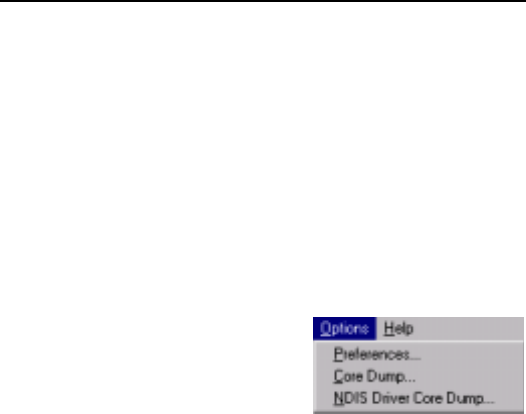
Section 3: Using the WinDGS Utilities
48
Radio Off/On
Radio Off/On allows you to selectively turn off or on the
power to the radio. Turning the radio off prevents all RF
energy from being transmitted by the PC Card.
Exit
Closes all windows and exits WinDGS.
Options Menu
The Options Menu includes:
•Preferences
•Core Dump
•NDIS Driver Core Dump
Preferences
The WinDGS Preferences allow you to customize various
parameters that control the operation of WinDGS. For
example, you can set the rate at which the values are
updated in the status and statistics screens via the Screen
Update Timer. You can also set the Save Properties
Options, which controls what is done with changes to the
current settings.
Screen Update Timer
The Screen Update Timer controls how often the statistics
and status screens are updated. The screen can be
updated in one second increments, from once a second to
once every 60 seconds. The default is once every five sec-
onds. You can use either the edit box or the slider to change
this value.
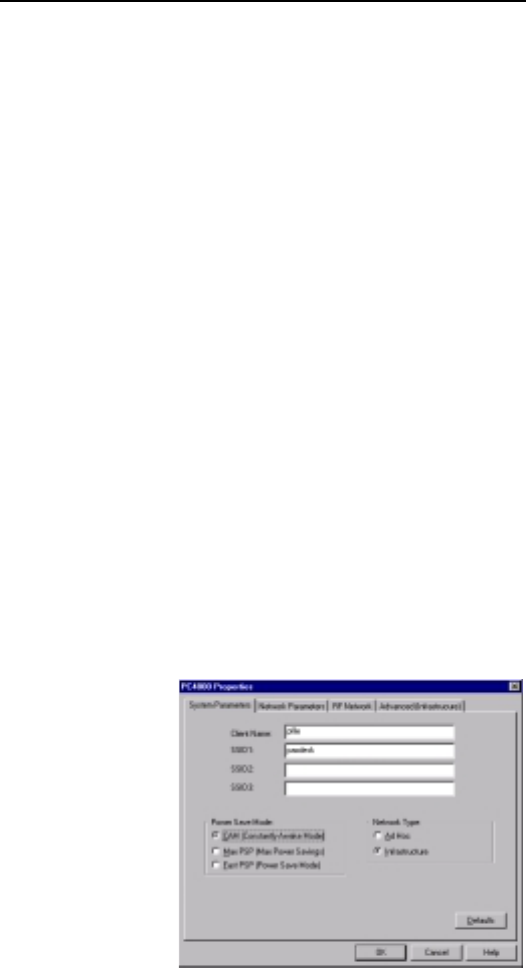
Section 3: Using the WinDGS Utilities
49
Status Bar Options
Use the Status Bar Options to include seconds on the clock
display on the WinDGS main screen.
Core Dump
Core Dump allows you to perform a core dump of the Wire-
less LAN Adapter’s firmware. Enter file names for core
dumps 1 and 2, or accept the defaults (C:\Aironet\Win-
DGS4_07\Core4800.1 and Core4800.2). Click the Do Core
Dump button to perform the dump.
NDIS Driver Core Dump
NDIS Driver Core Dump allows you to perform a core dump
of the Wireless LAN Adapter’s drivers. Enter a file name for
the core dump, or accept the default (C:\Aironet\Win-
DGS4_07\Core4800.cor). Click the Do Core Dump button
to perform the dump.
Using Edit Properties
The Edit Proper-
ties screen, which
you access from
the Commands
menu, includes
four “pages,”
which you select
by clicking the
tabs at the top of
the window:
•System
Parameters
• Network
Parameters

Section 3: Using the WinDGS Utilities
50
•RF Network Parameters
•Advanced (Infrastructure or Ad Hoc)
Each sub-screen is described below.
System Parameters
System parameters include:
•Name
•SSID
•Network Type (Infrastructure or Ad Hoc)
•Constant Awake Mode (CAM)
•Power Save Mode
•Fast Power Save Mode
•Maximum Power Save Mode
Name
The station name is displayed in the table of connected
devices on the Access Point. It provides a logical name
to determine which machines are connected without
having to memorize every MAC address. The name
can be up to 16 characters.
SSID
The Service Set Identifier (SSID) controls access to a
given wireless network. This value MUST match the
SSID of any/all Access Points that you want to commu-
nicate with. If the value does not match, access to the
system is not granted. The SSID can be up to 32 char-
acters (case sensitive).
Network type (Infrastructure Mode)
This mode is used to set up a connection to a wired
network, such as Ethernet or Token Ring. This mode
requires an Access Point to gain access to the wired
network.

Section 3: Using the WinDGS Utilities
51
Network type (Ad Hoc Mode)
This mode is used to set up a small, temporary network
between two or more computers. For example, you
might set up an ad hoc network between computers in
a conference room so users can share information in a
meeting.
Constant Awake Mode (CAM)
Constant Awake Mode is the normal mode for desktop
machines or other machines where power consumption
is not an issue. It keeps the radio powered up continu-
ously so there is little latency for responding to
messages. This mode is recommended for devices
where high availability is desired.
Power Save Mode
Power Save Mode is recommended for devices where
power consumption is a major concern, such as small
battery powered devices. If the client node is powered
from an AC line, PSP should not be used. Power Save
Mode causes the Access Point to buffer incoming mes-
sages. The Aironet 4000 Series Wireless LAN Adapter
must wake up periodically and poll the Access Point to
see if there are any buffered messages waiting. The PC
Card can request each message and then go back to
sleep.
Fast Power Save Mode
Fast Power Save Mode (Fast PSP Mode) switches
between PSP and CAM based on network traffic. When
retrieving a high number of packets, Fast PSP Mode
will switch to CAM to retrieve the packets. Once the
packets are retrieved, it switches back to PSP.
Maximum Power Save Mode
Maximum Power Save Mode (Max PSP Mode) can only
be used in conjunction with PS or Fast PSP Modes.This
mode allows the Aironet 4000 Series Wireless LAN

Section 3: Using the WinDGS Utilities
52
Adapter to conserve the most power while still main-
taining an infrastructure connection. Using Max PSP
Mode conserves power but will reduce throughput.
Network Parameters
User modifiable parameters are limited to the choice of
MAC Address:
•Factory MAC Address: This is the default MAC
address which is guaranteed to be unique. Unless you
have a very good reason to define your own MAC
address, it is STRONGLY RECOMMENDED that you
use the factory MAC address.
•User Defined MAC Address: If you must define your
own MAC address, you can enter it here. If you do not
use a unique value, you may not be able to communi-
cate to your wired network or you may disrupt other net-
work devices. For this reason, it is STRONGLY
RECOMMENDED that you use the factory MAC
address. The MAC address is 12 hexadecimal digits.
You do not need to use delimiters, but you can use
spaces or the colon character.
RF Network Parameters
RF Network Parameters include:
•Fragment Threshold: This parameter defines a thresh-
old above which the RF packet will be split up or frag-
mented. If a packet is fragmented or transmission of
part of it is interfered with, only the portion that was
unsuccessful would need to be re-sent. The throughput
will generally be lower for fragmented packets since the
fixed packet overhead consumes a higher portion of the
RF bandwidth.
•Data Retries: This parameter defines the number of
times a packet will be re-sent if the initial transmission is
unsuccessful. If the network protocol automatically re-
tries itself, set this to a small value. A “bad” packet sta-
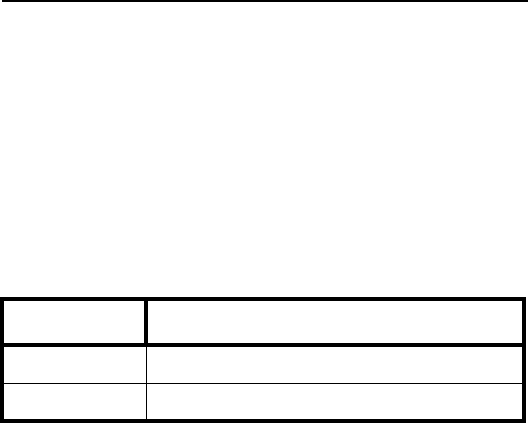
Section 3: Using the WinDGS Utilities
53
tus will be sent up the protocol stack more quickly so
the application can re-transmit the packet.
•Basic Data Rate: This parameter determines the data
rate used to transfer all management frames by the cli-
ent device when associated within a given Basic Ser-
vice Set (BSS). When operating in Infrastructure Mode,
this parameter should be set to correspond to the
Access Point setting. When operating in Ad Hoc Mode,
all stations should have the same setting.
•Authentication type: This parameter controls the vali-
dation of the WEP Key. Shared Key Authentication vali-
dates that the client is using the same WEP Key as the
Access Point. The Access Point sends a known, un-
encrypted “challenge packet” to the client. The client
then encrypts the challenge packet and sends it back to
the Access Point. The Access Point then attempts to
decrypt the encrypted challenge packet, and sends an
Authentication response packet indicating the success
or failure of the decryption back to the client. Open
Authentication does not check for a matching WEP
Key. The Shared Key selection is not available if the cli-
ent’s WEP Key is not set.
•Modulation: This parameter determines the type of
radio modulation that the Wireles LAN Adapter uses at
the 5.5 Mbps and 11 Mbps data rates. Older versions of
firmware use MOK modulation, while newer firmware
versions use the IEEE 802.11 Standard CCK modula-
tion. The modulation that the PC4800 uses must match
the modulation of the Access Point (in an Infrastructure
Mode configuration) or other Wireless LAN Adapters (in
an Ad Hoc Mode configuration). Otherwise, the radio
will not communicate with the other devices.
Model Allowable Selections
4500 1 Mbps or 2 Mbps
4800 1 Mbps, 2 Mbps, 5.5 Mbps, or 11 Mbps

Section 3: Using the WinDGS Utilities
54
•Supported Data Rates: This parameter specifies the
data rates that will be supported by a given radio device
in the BSS.
Advanced (Infrastructure)
The following parameters are contained in both the Infra-
structure and Ad Hoc Modes:
•Antenna Mode
•Specified Access Point
•RTS Threshold
•RTS Retry Limit
Antenna Mode
Three options are available for the type of antenna you
have connected to the Aironet 4000 Series Wireless
LAN Adapter:
•Antenna Diversity: This allows the PC Card to use
the stronger signal from the two antenna ports.
Diversity can help the radio maintain the RF
connection in areas of interference. Due to the
nature of how RF signals are affected by the
surroundings, one antenna may be in an RF “null”
where the signal is very weak, but the other
antenna (even though it is only a small distance
away) may have a stronger signal strength. The PC
Card would automatically select the antenna that
has the highest signal strength. Antenna Diversity
is the recommended setting for the standard
Snap-On antenna.
Model Allowable Selections
4500 1 Mbps, 1_2 Mbps, or 2 Mbps
4800 1 Mbps, 1_2 Mbps, 1_5.5 Mbps, 1_11 Mbps
2 Mbps, 2_5.5 Mbps, 2_11 Mbps,
5.5 Mbps, 5.5_11 Mbps, or 11 Mbps

Section 3: Using the WinDGS Utilities
55
•Right Antenna Only (J1): Choose this option if the
antenna you are using is connected to the right
hand antenna port and you are not using the
standard Snap-On antenna. The PC Card will not
attempt to communicate using the left hand
antenna port since no antenna is connected to it.
•Left Antenna Only (J2): Choose this option if the
antenna you are using is connected to the left hand
antenna port and you are not using the standard
Snap-On antenna. This tells the PC Card not to
attempt to communicate using the right hand
antenna port since no antenna is connected to it.
Specified Access Point
This parameter is the MAC address of the preferred
Access Point you want to associate with. It is important
to note that if you specify the Access Point, you MAY
associate to another Access Point if the Specified
Access Point is not found. If you roam out of range, you
will probably associate with another Access Point.
Setting a Specified Access Point will slow down the
roaming process. Thus, for normal operation for the
majority of users, leave this field blank.
RTS Threshold
This parameter controls what size data packet the low
level RF protocol issues to an RTS packet. There are
several trade-offs to consider when setting this
parameter. Setting this parameter to a small value
causes RTS packets to be sent more often, consuming
more of the available bandwidth, therefore reducing the
apparent throughput of other network packets. How-
ever, the more often RTS packets are sent, the quicker
the system can recover from interference or collisions.
Refer to the IEEE 802.11 Standard for more information
on the RTS/CTS mechanism.

Section 3: Using the WinDGS Utilities
56
RTS Retry Limit
This parameter controls the number of times the PC
Card will re-send the RTS packet if it does not receive a
CTS from the previously sent RTS packet. Setting this
to a large value will decrease the available bandwidth
whenever interference is encountered, but will make
the system more immune to interference and collisions.
Refer to the IEEE 802.11 Standard for more information
on the RTS/CTS mechanism.
Advanced (Ad Hoc/IBSS)
In Ad Hoc Mode, you can also modify the following
parameters:
•Channel
•Beacon Period
•Wake Duration
Channel
This parameter specifies the channel identifier the unit
will use if it must start its own network. For all other situ-
ations, the radio will scan for the proper frequency. See
Appendix C for channel identifier parameters.
Beacon Period
This parameter specifies the duration between beacon
packets that are used by IEEE 802.11 systems to
synchronize the “hops” (change to another frequency).
The beacon packet contains timing information and hop
pattern information that is broadcast over the airwaves.
Any station that can hear the beacon packet can then
synchronize their internal timer so that it can hop at the
correct time. The default beacon period is one-half of
the dwell period so two beacons are transmitted per
hop dwell period (default is 100 Kµsec). Refer to the
IEEE 802.11 Standard for more information on the
timing and scanning mechanism.
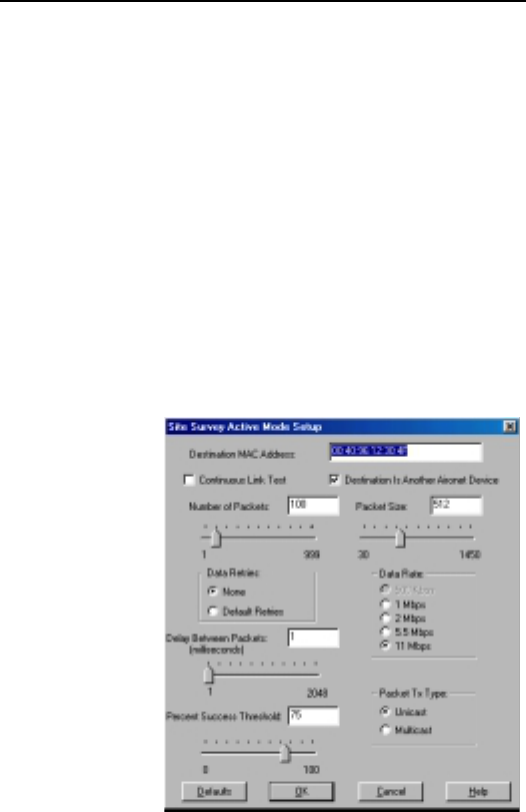
Section 3: Using the WinDGS Utilities
57
Wake Duration
This parameter specifies the amount of time per Hop
Dwell Period that the adapter stays awake listening for
data packets. This is only used in Power Save Mode.
Using the Site Survey Active
Mode Feature
If your PC4800 Wireless LAN Adapter contains the latest
firmware, and if you have the latest drivers on your system,
you can use the Site Survey Active Mode feature to set up a
customized link test.
When you select
Site Survey from
the Commands
menu and click
the Setup but-
ton at the bot-
tom of the
window, the
Setup window
appears. Each
setting is
described
below.
Destina-
tion MAC
Address
This parameter specifies the Access Point that will be
involved in the test. The default is the MAC address of the
AP the Aironet Wireless LAN Adapter is currently associ-
ated with.

Section 3: Using the WinDGS Utilities
58
Continuous Link Test
If you click this check box, the Active Mode test will run
repeatedly until you press the OK or Stop buttons on the
Site Survey page. (The test will loop repeatedly for the num-
ber of packets you specify on the Number of Packets set-
ting.)
Destination is Another Aironet Device
Click this check box if the Access Point you named in the
Destination MAC Address field is an Aironet Access Point.
Number of Packets
This parameter sets the quantity of packets that will be sent
during the test.
Packet Size
This parameter sets the size of the packets that will be sent
during the test. You should use a packet size that will be
typical during normal use of the system.
Data Retries
This parameter sets the number of times a transmission will
be retried if an ACK is not returned by the destination
device. Click None for no retries, or Default Retries for the
firmware’s default value for retries.
Data Rates
This parameter sets the bit rate at which packets will be
transmitted. No rate shifting will occur during the test.

Section 3: Using the WinDGS Utilities
59
Delay Between Packets
This parameter sets the delay (in milliseconds) between
successive transmissions.
Packet Tx Type
This parameter sets the packet type that will be used during
the test. If you select Unicast, the system will expect an
ACK back from the destination, and retries can occur. If you
select Multicast, no packet retries will occur during the test.
Packet Success Threshold
This parameter controls the red line on the “Percent Suc-
cessful” histogram. Percentages greater than or equal to
this value will show up as green bars, while percentages
below this value will show up as yellow bars on the Percent
Successful histogram.
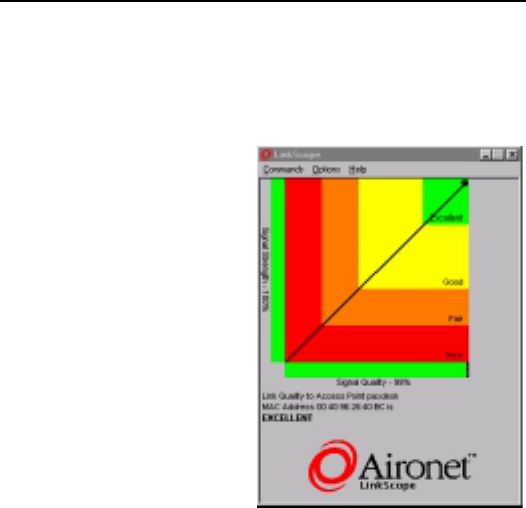
Section 3: Using the WinDGS Utilities
60
Using the Linkscope Utility
The Linkscope utility provides a graphical display of:
•Signal Quality
•Signal Strength
Linkscope determines
the performance of the
RF link between a PC
Card and an Aironet
Access Point. Any Win-
dows 95, Windows 98,
or Windows NT unit
associated to an Airo-
net Access Point can
run the linkscope test.
Signal strength is dis-
played along the verti-
cal axis of the graphical
display. Signal quality is displayed along the horizontal
axis. The combined result is represented by a diagonal
line. The Aironet Access Point associating with the PC
Card is indicated along the bottom of the display as well
as its MAC address. For more information on the Airo-
net Access Point testing procedures, see the appropri-
ate Access Point Technical Reference Manual.

Error Messages and Troubleshooting
61
Section 4
Error Messages and Trouble-
shooting
The Wireless LAN Adapter provides LED messages and
error codes. This section provides the general procedures
for correcting common problems encountered when
installing the PC Card system.
Indicator LEDs
The PC Card has two indicator LEDs (green and amber) on
the face of the card.
The green indicator is the Link Integrity/Power LED. It lights
when the card is receiving power and flashes slowly when
the PC Card is linked with the network.
The amber indicator is the Link Activity LED. It flashes when
the PC Card is receiving or transmitting data or in a pattern
to indicate an error condition.
See Tables 4.1 and 4.2 for an explanation of the LED
Messages.

Error Messages and Troubleshooting
62
Table 4.1 – Green LED Operating Messages
Table 4.2 – Amber LED Operating Messages
Green LED Condition
Off No power or error
Flashing Quickly Power on, self-test OK, scanning for network
Flashing Slowly Associated with an infrastructure network
Amber LED Green LED Condition
Flashing Continuously on or
flashing slowly PC Card is transmitting or
receiving data while
associated with an Access
Point
Flashing in a Pattern Continuously on Indicates an error
condition

Error Messages and Troubleshooting
63
If Your Radio Fails to Establish Contact
• Change your location or the location of the antenna by
a few feet and try again.
• Make sure the antenna is securely attached.
• Make sure the PC Card is securely inserted in the PC
Card slot.
• Make sure the receiving equipment is turned on and
operating.
• Make sure the receiving equipment is properly con-
nected to the host computer.
• Check that all parameters are set properly for both the
PC Card and the Aironet Access Point.
If the radio fails to establish contact, contact Aironet Techni-
cal Support for additional assistance:
Phone - (330) 664-7903
Fax - (330) 664-7990
e-mail - techsupp@aironet.com
http://www. aironet.com

Error Messages and Troubleshooting
64

Appendix A: Aironet Wireless LAN Adapter Overview
65
Appendix A
Aironet Wireless LAN Adapter
Overview
The Aironet 4800 Series Wireless LAN Adapter is a PC
Card radio module that provides transparent wireless data
communications between fixed, portable, or mobile devices
and other wireless devices or a wired network infrastructure
(Ethernet or Token Ring). Host devices can be any device
equipped with a PC Card Type II or Type III slot. These
devices include:
• Desktop systems
• Portable laptops
• Notebook computers
• Personal digital assistants
• Pen based computers
• Other data collection devices
The PC Card is fully compatible when used in a device
supporting Plug-and-Play technology.
The PC Card can also be built into peripheral devices such
as printers to provide a transparent wireless connection to a
wired network.

Appendix A: Aironet Wireless LAN Adapter Overview
66
Safety Information
The FCC with its action in ET Docket 96-8 has adopted a
safety standard for human exposure to radio frequency
(RF) electromagnetic energy emitted by FCC certified
equipment. The Aironet products meet the uncontrolled
environmental limits found in OET-65 and ANSI C95.1,
1991. Proper operation of this radio according to the
instructions found in this manual will result in exposure
substantially below the FCC’s recommended limits.
•Do not touch or move antenna(s) while the unit is
transmitting or receiving.
•Do not hold any component containing the radio so that
the antenna is very close or touching any exposed parts
of the body, especially the face or eyes, while transmit-
ting.
•Do not operate a portable transmitter near unshielded
blasting caps or in an explosive environment unless it
is a type especially qualified for such use.
•Do not operate radio or attempt to transmit data unless
the antenna is connected; if the antenna is not con-
nected, the radio may be damaged.
Snap-On Antenna
Always orient the antenna so that it is at least 5 cm (2
inches) away from your body.

Appendix A: Aironet Wireless LAN Adapter Overview
67
Dipole Antenna
Always orient the antenna so that it is at least 15 cm
(six inches) away from your body.
High Gain Antennas
High gain wall mount or mast mount antennas are
designed to be professionally installed and should be
located at a minimum distance of 30 cm (12 inches) or
more from your body. Please contact your professional
installer, VAR, or antenna manufacturer for proper
installation requirements.
Warning for Laptop User
To comply with the FCC RF exposure limits, it is recom-
mended when using a laptop with the snap-on antenna,
that the antenna should not be positioned closer than 5
cm (two inches) from your body or nearby persons for
extended periods of time while it is transmitting (or
operating). If the antenna is positioned less than 5 cm
(two inches) from the user, it is recommended that the
user limit exposure time.
Other Devices in the Wireless Network
Refer to the User’s Guide and Technical Reference
manual for the Access Point, Universal Client, or Bridge
for additional information.

Appendix A: Aironet Wireless LAN Adapter Overview
68
Radio Characteristics
The PC Card operates in the 2.4 GHz license-free Industrial
Scientific and Medical (ISM) band. Data is transmitted over
a half-duplex radio channel operating up to 2 Megabits per
second (Mbps) for the PC4500 or up to 11 Mbps for the
PC4800.
Direct Sequence Radio Technology
The Aironet 4800 Series Wireless LAN Adapter uses Direct
Sequence Spread Spectrum (DSSS) transmission originally
developed for military “anti-jamming” and “low probability of
intercept” radio systems. The signal is transmitted over a
wide frequency range, using multiple frequencies simulta-
neously. This protects the data transmission from interfer-
ence.
If a particular frequency encounters a level of noise and/or
interference, there is enough redundancy built into the sig-
nal on other frequencies that the Aironet 4800 Series Wire-
less LAN Adapter will usually still be successful in its
transmission.
Data Transparency and Protocols
The Aironet 4800 Series Wireless LAN Adapter transports
data packets transparently as they move through the wire-
less infrastructure. The PC Card operates similarly to a
standard network product except the wire is replaced with a
radio connection. No special wireless networking functions
are required. All existing applications, which operate over a
network, will operate using the Aironet 4800 Series Wire-
less LAN Adapter.
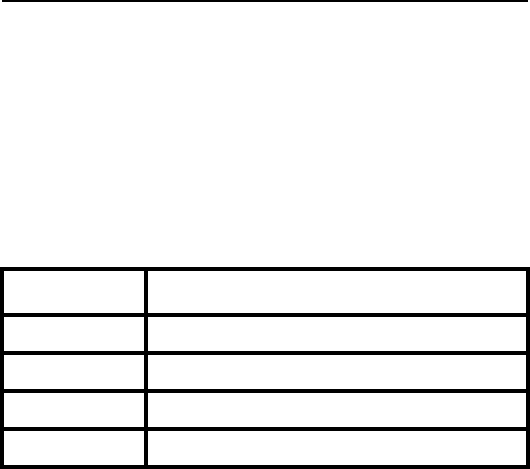
Appendix A: Aironet Wireless LAN Adapter Overview
69
Protocols Supported
The Aironet 4800 Series Wireless LAN Adapter can be
used in a variety of infrastructure configurations. Aironet
Access Points (AP4500 and AP4800) provide connections
to Ethernet or Token Ring Networks. When using the Airo-
net standard device drivers, the PC Card is fully compliant
with the following protocols and wired networks:
Radio Ranges
This section provides general guidelines on factors that
influence network performance (see Section 4 - Site
Survey and Link Test).
Site Survey
Because of differences in component configuration,
placement and physical environment, every network
application is a unique installation. Before installing the
system, users should perform a site survey to deter-
mine the optimum utilization of networking components
and to maximize range, coverage and network perfor-
mance.
Here are some operating and environmental conditions you
should consider:
•Data Rates. Sensitivity and range are inversely propor-
tional to data bit rates. The maximum radio range is
achieved at the lowest workable data rate. There will be
Drivers Operating System
ODI DOS based driver for Novell NetWare
NDIS2 MS DOS, Windows 3.xx
NDIS3 Windows 95, Windows 98, Windows NT
Packet MS DOS, Windows 3.xx

Appendix A: Aironet Wireless LAN Adapter Overview
70
a decrease in receiver threshold sensitivity as the radio
data rate increases.
•Antenna Type and Placement. Proper antenna config-
uration is a critical factor in maximizing radio range. As
a general guide, range increases in proportion to
antenna height.
For a detailed explanation of antenna types and config-
urations along with guidelines on selecting antennas for
specific environments, see the Aironet Antenna Guide,
document number 710-003725.
•Physical Environments. Clear or open areas provide
better radio range than closed or filled areas. Also, the
less cluttered the work environment, the greater the
range.
•Obstructions. A physical obstruction such as metal
shelving or a steel pillar can hinder the performance of
the PC Card, particularly when using the small Snap-
On antenna. Avoid locating the computing device and
antenna in a location where there is a metal barrier
between the sending and receiving antennas.
•Building Materials. Radio penetration is greatly influ-
enced by the building material used in construction. For
example, drywall construction allows greater range
than concrete blocks. Metal or steel construction is a
barrier to radio signals.
Link Test
The link test tool is used to determine RF coverage.
The test results help the installer eliminate low RF sig-
nal level area that can result in loss of connection.
Radio Antenna
The Snap-On Diversity antenna comes standard with the
PC Card and provides omni-directional coverage.

Appendix A: Aironet Wireless LAN Adapter Overview
71
A benefit of the diversity antenna system is improved cover-
age. At the edges of the RF coverage or fringe areas, there
are very often multiple signals reaching the receiver, all
from the same transmitter. These signals travel in different
paths (multipath) and are caused by reflection and shadows
of the RF signals. When the signals combine, the receiver
may have trouble decoding the data. The Aironet radio’s
ability to switch and sample between these antennas allows
it to select the optimum antenna for receiving the packet.
Optional antennas are offered for the PC Card. Consult the
Aironet Antenna Guide (document number 710-003725) for
more information.
Security Features
The Aironet 4800 Series Wireless LAN Adapter employs
Direct Sequence Spread Spectrum Technology, previously
developed for military “anti-jamming” and “low probability of
intercept” radio systems.
The Aironet Access Point must be set to the same Service
Set Identifier (SSID) as all other Aironet devices on the
wireless infrastructure. Units with a different SSID will not
be able to directly communicate with each other.
Terminology
When configuring your system, and when reading this man-
ual, keep in mind the following terminology:
Association – Each root unit or repeater in the infrastruc-
ture contains an association table that controls the routing
of packets between the Access Point and the wireless infra-
structure. The association table maintains entries for all the
nodes situated below the Access Point on the infrastructure
including repeaters and client nodes.
End Node – A client node that is located at the end of the
Network Tree.

Appendix A: Aironet Wireless LAN Adapter Overview
72
Infrastructure – The wireless infrastructure is the commu-
nications system that combines Access Points, mobile
nodes and fixed nodes. Access Points within the infrastruc-
ture can be either root units, which are physically wired to
the LAN backbone, or can act as wireless repeaters. Other
RF enabled devices serve as fixed nodes or mobile client
nodes.
Parent/Child Node – Refers to the relationships between
nodes in the wireless infrastructure. The complete set of
relationships is sometimes described as a Network Tree.
For example, the Access Point (at the top of the tree) would
be the parent of the end nodes. Conversely, the end nodes
would be the children of the Access Point.
Power Saving Protocol (PSP) and Non-Power Saving
Protocol – The Power Saving Protocol allows computers
(usually portable computers) to power up only part of the
time to conserve energy. If a client node is using the Power
Saving Protocol to communicate with the network, the Airo-
net Access Point must be aware of this mode and imple-
ment additional features such as message store and
forward. If the client node is powered from an AC line, PSP
should not be used.
Repeater – A repeater is an Access Point that extends the
radio range of the infrastructure. A repeater is not physically
attached to the wired LAN, but communicates via radio to
another Access Point, which is either a root unit or another
repeater.
Root Unit – The root unit is an Access Point that is located
at the top, or starting point, of a wireless infrastructure. A
root unit provides the physical connection to the wired LAN
(such as Ethernet or Token Ring) and contains configura-
tion information in its association table that covers all nodes
that access the wired network (backbone). All Access
Points directly attached to the wired LAN backbone are root
units.
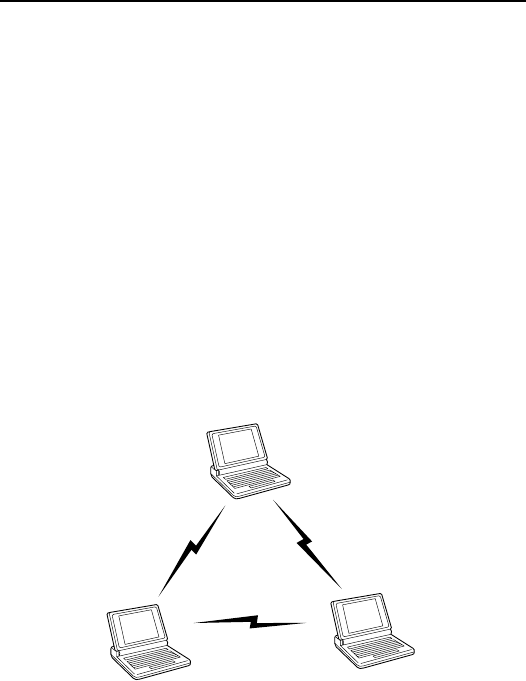
Appendix A: Aironet Wireless LAN Adapter Overview
73
System Configurations
The Aironet 4800 Series Wireless LAN Adapter can be
used in a variety of network system configurations. Aironet
Access Points (AP4500 or AP4800) provide connections to
your Ethernet or Token Ring networks or act as repeaters
increasing wireless communication range. The maximum
communication range is based on how you configure your
wireless infrastructure.
Examples of some common system configurations are
shown on the pages that follow, along with a description of
each.
Figure 1.1 - Ad Hoc Wireless LAN
An ad hoc wireless LAN is the simplest wireless LAN con-
figuration. In a wireless LAN, using an ad hoc network oper-
ating system (such as Windows for Workgroups or
Windows 95), all devices equipped with the PC Card can be
linked together and communicate directly with each other.
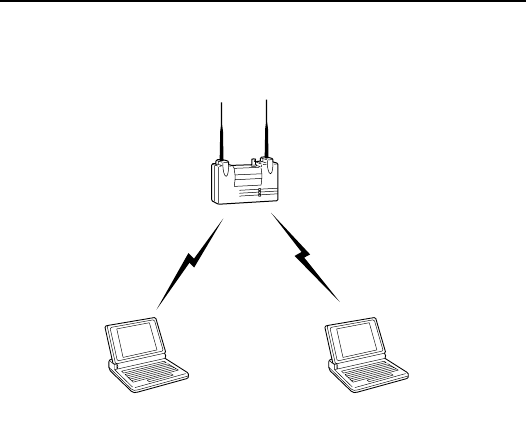
Appendix A: Aironet Wireless LAN Adapter Overview
74
Figure 1.2 - Wireless Infrastructure
In a wireless infrastructure, an Aironet Access Point is used
as a stand-alone root unit. The root unit is not attached to
any wired LAN (such as an Ethernet or Token Ring LAN),
but functions as a hub linking all stations together. This
configuration is similar to the ad hoc network, except the
Aironet Access Point serves as the focal point for communi-
cations. This increases the effective communication range
over the ad hoc LAN since both stations are not required to
be in direct communication range of each other.
Workstation Workstation
Access Point
(Root Unit)
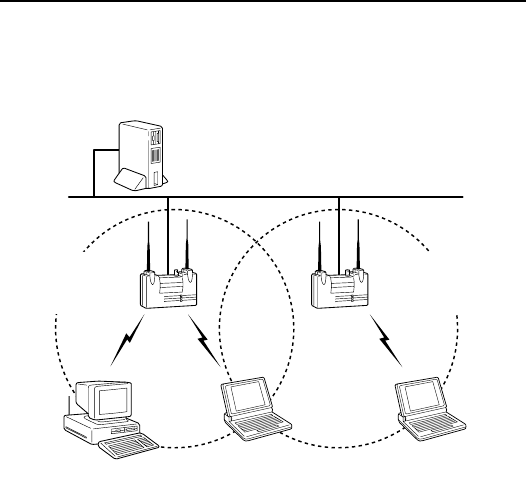
Appendix A: Aironet Wireless LAN Adapter Overview
75
Figure 1.3 - Wireless Infrastructure with Workstations
Accessing a Wired LAN
A Micro-Cellular Network can be created by placing two or
more Aironet Access Points on a LAN.
The Aironet roaming protocols allow remote workstations to
move from one microcell domain to another. The process is
seamless and transparent. The connection to the file server
or host is maintained without disruption. This configuration
is useful with portable or mobile stations allowing them to
be directly connected to the wired network, even while mov-
ing about (roaming). When an infrastructure is configured
using multiple Aironet Access Points and/or repeaters, a
mobile station is automatically associated and re-associ-
ated to the Aironet Access Point which provides the best
performance. This is referred to as seamless roaming.
File Server
Wired LAN
Workstation Workstation Workstation
Aironet
Access Point
(Root Unit)
Aironet
Access Point
(Root Unit)
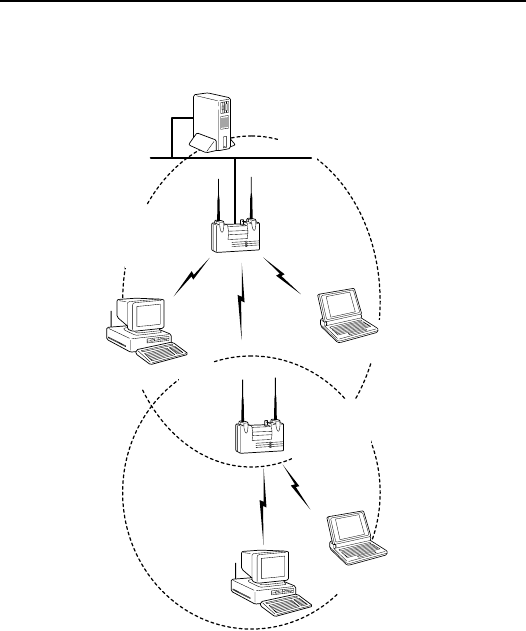
Appendix A: Aironet Wireless LAN Adapter Overview
76
Figure 1.4 - Extended Infrastructure Using Repeaters
An Aironet Access Point can be configured as a stand-
alone repeater to extend the range of your infrastructure, or
to overcome an RF blocking obstacle. The repeater for-
wards traffic between the Aironet 4800 Series Wireless LAN
Adapter equipped workstations and devices and the wired
LAN by sending packets to either another repeater or to
another Aironet Access Point attached to the wired LAN.
The data is sent through whichever route provides the
greatest performance for the client. Multiple repeater hops
can be supported in the path to the wired LAN.
File Server
Wired LAN
Workstation
Aironet
Access Point
(Root Unit)
Aironet
Access Point
(Repeater)
Workstation
Workstation
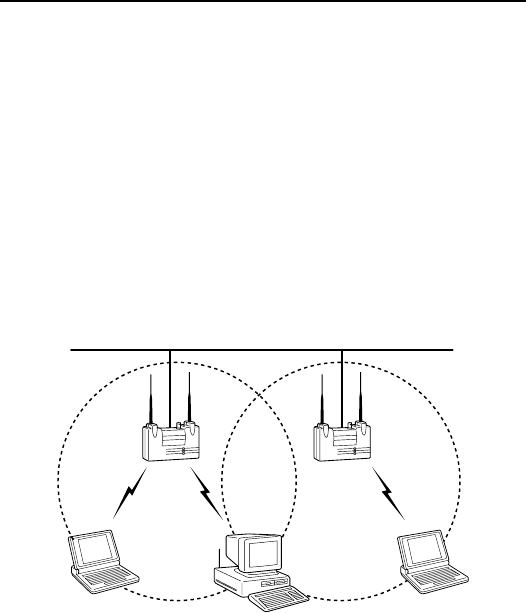
Appendix A: Aironet Wireless LAN Adapter Overview
77
Coverage Options
The system architecture options of the wireless station and
Access Points provide for a variety of coverage alternatives
and flexibility. The system can be designed to provide a
wide coverage area with minimal overlap (Figure 1.5) or
coverage with heavy overlap (Figure 1.6). The latter
improves system performance and protection against
downtime in the event of a component failure.
Figure 1.5 - Minimal Overlap Coverage Option
By arranging the Access Points so the overlap in coverage
area is minimized, a large area can be covered with minimal
system cost. The total bandwidth available to each mobile
station will depend on the amount of data each mobile sta-
tion desires to transfer and the number of stations located in
each cell. Seamless roaming is supported as a mobile sta-
tion moves in and out of range of each Access Point,
thereby maintaining a constant connection to the wired
LAN. Each Access Point (and PC Card) must be configured
with the same Service Set Identifier (SSID) in order to pro-
vide the roaming capability.
Wired LAN
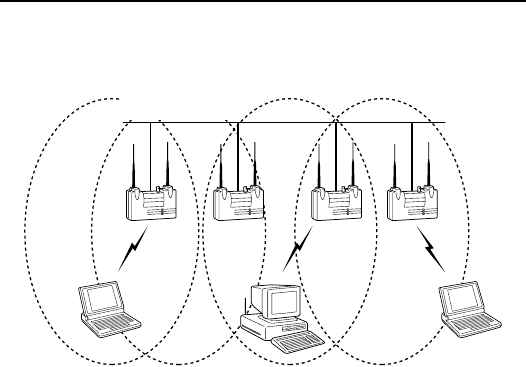
Appendix A: Aironet Wireless LAN Adapter Overview
78
Figure 1.6 - Heavy Overlap Coverage Option
By arranging the Access Points so the overlap in coverage
area is nearly maximized, a large number of mobile stations
can be supported in the same wireless infrastructure. How-
ever, units in overlapping coverage areas on the same fre-
quency will detect adjacent cell traffic and delay
transmissions that would cause collisions. This reduces the
aggregate radio system throughput. Heavy cell overlap is
not recommended for maximum system throughput. Due to
the redundancy in coverage overlap, system access is not
lost in the event of an Access Point failure. Upon failure of
the Access Point, the station will automatically roam to an
operational Access Point. With this architecture, all Access
Points and PC Card units must be configured with the same
Service Set Identifier (SSID).
Wired LAN
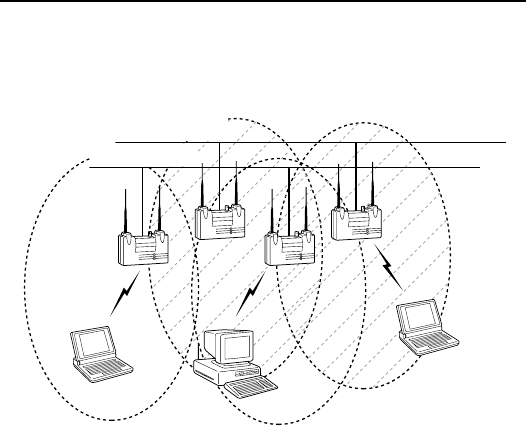
Appendix A: Aironet Wireless LAN Adapter Overview
79
Figure 1.7 - Multiple Overlapping Systems Coverage
Option
Multiple systems can operate in the same vicinity. The
architecture provides multiple channels, which can exist in
the same area with virtually no interference to each other. In
this mode, each system must be configured with different
Service Set Identifiers (SSID) and different channels, which
prevent clients from roaming to Access Points of a different
wireless system.
Wired LAN 1
Wired LAN 2

Appendix A: Aironet Wireless LAN Adapter Overview
80

Appendix B: PC Card Specifications
81
Appendix B
PC Card Specifications
LAN Drivers Supported
Table B.1 – Supported Drivers
Protocol Operating System
ODI DOS based driver for Novell Netware
NDIS 2 MS DOS, Windows 3.xx
NDIS 3 Windows 95, Windows 98, Windows NT
Packet MS DOS, Windows 3.xx
AppenBspecs.fm Page 81 Monday, October 18, 1999 1:54 PM

Appendix B: PC Card Specifications
82
Radio Specifications
Table B.2 – Radio Specifications
Item Specification Description
Radio Type Direct Sequence 2.4 GHz ISM Band
Operating
Frequency 2400-2497 MHz North American, ETSI, and
Japan channel coverage,
factory configurable
FCC ID LOZ102036 FCC approval
Channeling 1 MHz increments Programmable for IEEE 802.11
Type of Modulation BPSK 1 Mbit/s
QPSK 2 Mbit/s
CCK 5.5 and 11 Mbits/s
Nominal 10 MHz BW (-6 db)
Power Output
(North American
Configuration)
30 mW Meets FCC Part 15.247
requirements
Antenna Type Diversity Integrated antenna
Antenna Connec-
tors 2 Amphenol MicroMate
female Unique connector per FCC Part
15.203. Snap-On with 1.5-2.5
lb retension force
Mating Cable
Connectors Huber & Suhner:
Amphenol: MMCX-50 Series
MicroMate Series PCMCIA Connector Card Connector Per PC Card
(Nov 95) Physical
Specification 4.1
AppenBspecs.fm Page 82 Monday, October 18, 1999 1:54 PM

Appendix B: PC Card Specifications
83
Power Requirements
Table B.3 – Power Requirements
Physical Specifications
Table B.4 – Physical Characteristics
Specification Value
Operational Voltage 5.0V ±0.25 Volts
Receive Mode Current 260 mA (220 mA typically)
High Power Transmit Mode
Current (30 mW) 490 mA (350 mA typically)
Sleep Mode Current 10 mA
Item Description
Size 3.37" L x 2.13" W x .20" H
(8.56 cm L x 5.41 cm W x .51 cm H)
Enclosure PC Card Type II
Weight 1.3 oz.
Operating Temperature 0° C to 70° C minimum (-22° F to 158° F)
Storage Temperature -40° C to +85° C (-40° F to 185° F)
Humidity, Shock, Drop,
Vibration, Thermal Shock per PC Card version 2.01, section 13.6.2
specifications
ESD 15kV (human body model)
Connectors 68-pin PC Card
Status Indicators Green and Amber LEDs – link association/activity
AppenBspecs.fm Page 83 Monday, October 18, 1999 1:54 PM
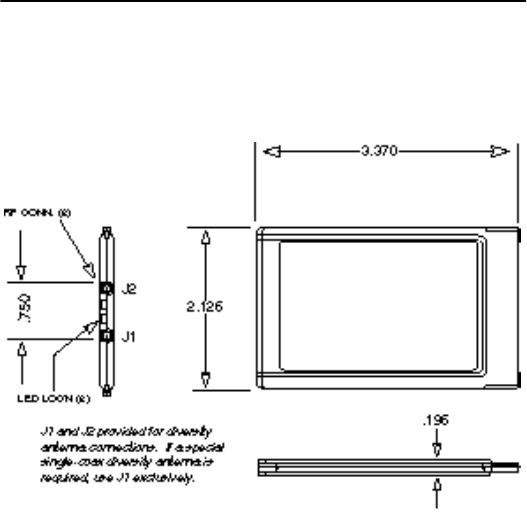
Appendix B: PC Card Specifications
84
Mechanical Description
Figure B.1 – Mechanical Outline
AppenBspecs.fm Page 84 Monday, October 18, 1999 1:54 PM

Appendix C: Channels
85
Appendix C
Channels
The channel identifiers and the channel center frequencies
of each 22 MHz wide channel are shown in the table below,
as appropriate for the various areas or regulatory agencies.
Regulatory Domains
Channel
Identifier Center
Frequency North
America ETSI Spain France Japan
1 2412 MHz X X - - -
2 2417 Mhz X X - - -
3 2422 MHz X X - - -
4 2427 Mhz X X - - -
5 2432 Mhz X X - - -
6 2437 Mhz X X - - -
7 2442 MHz X X - - -
8 2447 MHz X X - - -
9 2452 MHz X X - - -
10 2457 MHz X X X X -
11 2462 MHz X X X X -
12 2467 MHz - X - X -
13 2472 MHz - X - X -
14 2484 MHz - - - - X

Appendix C: Channels
86

Appendix D: Declarations of Conformity
87
Tested To Comply
With FCC Standards
FOR HOME OR OFFICE USE
Appendix D
Declarations of Conformity
Manufacturers Federal Communica-
tion Commission Declaration of
Conformity Statement
Models: PC4500, PC4800
Manufacturer:
Aironet Wireless Communications, Inc.
3875 Embassy Parkway
Akron, OH 44333-8357
330-664-7900
This device complies with Part 15 rules. Operation is sub-
ject to the following two conditions:
1) this device may not cause harmful interference, and 2)
this device must accept any interference received, including
interference that may cause undesired operation.
This equipment has been tested and found to comply with
the limits of a Class B digital device, pursuant to Part 15 of
the FCC Rules. These limits are designed to provide rea-
sonable protection against harmful interference when the
equipment is operated in a residential environment. This
equipment generates, uses, and radiates radio frequency
energy, and if not installed and used in accordance with the
instructions, may cause harmful interference. However,
there is no guarantee that interference will not occur. If this
equipment does cause interference to radio or television
reception, which can be determined by turning the equip-
ment off and on, the user is encouraged to correct the inter-
ference by one of the following measures:
• Reorient or relocate the receiving antenna.

Appendix D: Declarations of Conformity
88
•Increase separation between the equipment and
receiver.
•Connect the equipment into an outlet on a circuit differ-
ent from which the receiver is connected.
•Consult the dealer or an experienced radio\TV techni-
cian.
User Warning
The Part 15 radio device operates on a non-interference
basis with other devices operating at this frequency. Any

Appendix D: Declarations of Conformity
89
Department of Communications—Canada
Canadian Compliance Statement
This Class B Digital apparatus meets all the requirements of
the Canadian Interference - Causing Equipment Regula-
tions.
Cet appareil numerique de la classe B respecte les exi-
gences du Reglement sur le material broilleur du Canada.
This device complies with RSS-210 of Industry of Canada.
Operation is subject to the following two conditions: 1) this
device may not cause harmful interference, and 2) this
device must accept any interference received, including
interference that may cause undesired operation.
The device is certified to the requirements of RSS-139-1 for
2.4 GHz spread spectrum devices. The use of this device in
a system operating either partially or completely outdoors
may require the user to obtain a license for the system
according to the Canadian regulations. For further informa-
tion, contact your local Industry Canada office.

Appendix D: Declarations of Conformity
90
European Telecommunication Standards Institute
Statement of Compliance
Information to User
This equipment has been tested and found to comply with
the European Telecommunications Standard ETS 300.328.
This standard covers Wideband Data Transmission Sys-
tems referred in CEPT recommendation T/R 10.01.
This type accepted equipment is designed to provide rea-
sonable protection against harmful interference when the
equipment is operated in a commercial environment. This
equipment generates, uses, and can radiate radio fre-
quency energy, and if not installed and used in accordance
with the instruction manual, may cause harmful interference
to radio communications.
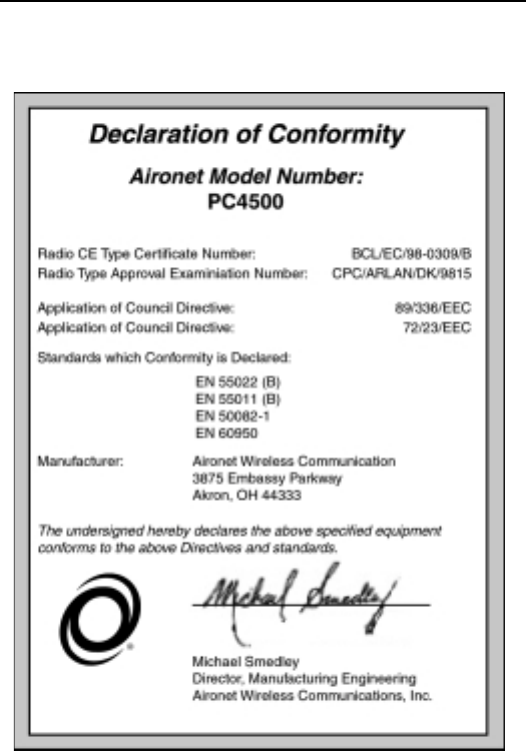
Appendix D: Declarations of Conformity
91
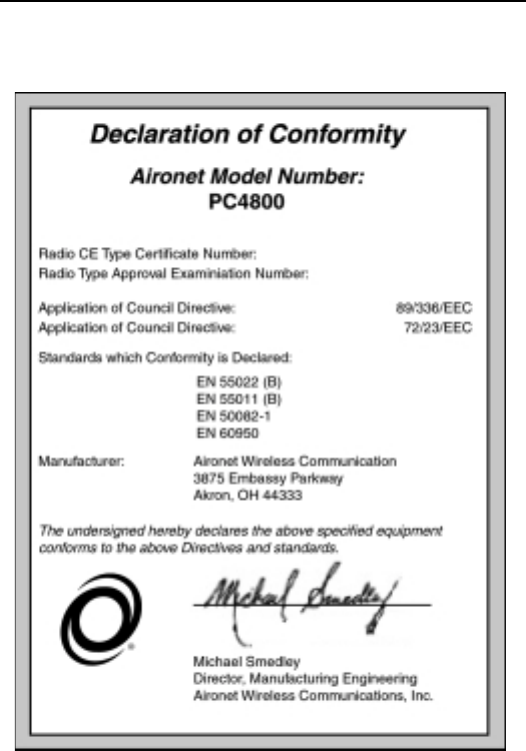
Appendix D: Declarations of Conformity
92

Appendix E: Technical Support
93
Appendix E
Technical Support
Communications
Use the following information to contact the Aironet
Technical Support group:
Telephone: (330) 664-7903
Fax: (330) 664-7990
e-mail: techsupp@aironet.com
Web Site
For additional product information and technical sup-
port, including the capability to download new firmware
and drivers, use the Aironet web site at:
http://www.aironet.com

Appendix E: Technical Support
94